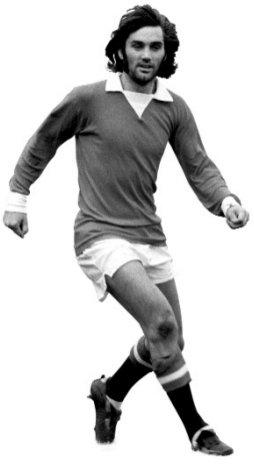SHOULD AULD ACQUAINTANCE BE FORGOT…
George Best famously ‘retired’ to Marbella in 1972, before coming back again and eventually leaving Manchester United for good in January 1974. George Best’s United career deteriorated during the 1970s and, after a series of on-off retirements and a dip in form, he left United for good on New Year’s Day 1974 after his final game against QPR. Many aspects contributed to the eventual and, some would say inevitable, day that George Best left United for good.

George ‘retired’ to Marbella in 1972.
In December 1972 other exits were being enforced at Manchester United. In fact, the Guardian suggested that ‘Manchester United’s most momentous day since the Munich disaster in February 1958’ was when United’s manager, Frank O’Farrell, and chief coach, Malcolm Musgrave, along with chief scout John Aston, were dismissed just before Christmas 1972.
This ‘momentous’ decision was taken during a morning board meeting when chairman Louis Edwards released a statement: ‘In view of the poor position of the club in the league, it was unanimously decided…’ Also decided at the same board meeting was that George Best was to remain on the transfer list as ‘it is felt that it is in the best interests of the club that he leaves Old Trafford.’
However, when Les Olive, United’s secretary, arrived at Old Trafford in preparation for the afternoon’s board meeting he was handed a typed letter from George who, so far as was known, was unaware of the board’s earlier decision:
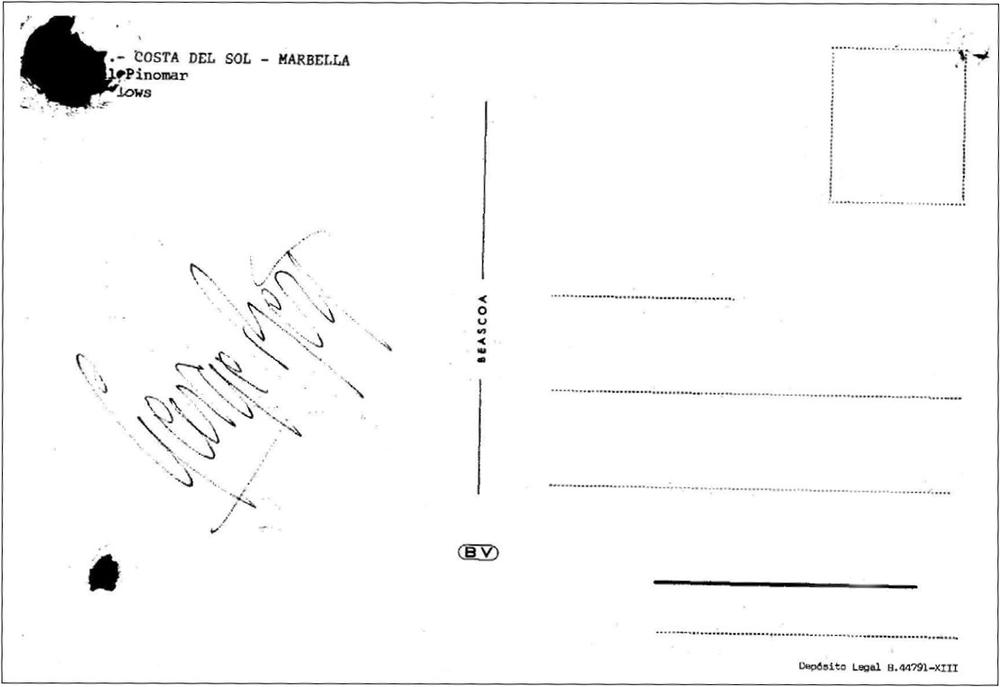
I had thought seriously of coming personally and asking for a chance to speak at the board meeting, but once again I am afraid when it comes to saying things face to face, I might not have been completely honest. I am afraid from my somewhat unorthodox ways of trying to sort my own problems out I have caused Manchester United even bigger problems.
I wanted you to read this letter before the board meeting commenced so as to let you know my feelings before any decisions or statements are issued following the meeting.
When I said last summer I was going to quit football, contrary to what many people said or thought, I seriously meant it because I had lost interest in the game for various reasons. While in Spain I received a lot of letters from both friends and well wishers – quite a few asking me to reconsider. I did so and after weeks of thinking it over I decided to give it another try. It was an even harder decision to make than the original one.
I came back hoping that my appetite for the game would return and even though in every game I gave 100 per cent there was something missing. Even now I am not quite sure what.
Therefore I have decided not to play football again and this time no one will change my mind.
I would like to wish the club the best of luck for the remainder of the season and for the future, because even though I personally have tarnished the club’s name in recent times, to me and thousands of others Manchester United still means something special.
George Best
The whole of the football world and indeed the national and international press were focusing on the increasingly wayward behaviour off the field and alcohol-related problems that had impaired George’s health and ultimately shortened his career. A rift had developed between the club and player as off-field problems and the pressures of superstardom took their toll.
But George walked out on the club on a number of occasions. After he ran off to Marbella, he returned to Manchester United in September 1973 but finally broke both Tommy Docherty’s and Manchester United’s patience when he failed to turn up for training in January 1974. His final league match for United had been in a disappointing 0–3 defeat against Queens Park Rangers on New Year’s Day 1974.

The match programmefrom George’s last game for Manchester United.
And so it was over.
On Tuesday, 1 January 1974, against Queens Park Rangers, George Best played his last competitive game for Manchester United. George Best, who started his professional career in 1963 at the age of 17 with Manchester United, made an immediate impact on the game. In full flow with the ball, he was a hypnotic blend of litheness and movement. He invited and evaded tackles like a matador taunting a bull. He would score goals beyond the imagination of ordinary players.
It would be interesting to know if George joined in with ‘For auld lang syne my dear for auld lang syne… We’ll take a cup of kindness yet for auld lang syne’ that New Year’s Day in 1974, and, if he did, who he was singing it with, or to.
FROM TYPHOO TEA TO WORCESTER COLLEGE XI
There is a great temptation to offer a spot the difference on two pictures of football teams shown here. So what’s the link?
Just a few years before the Worcester College picture was taken, a young boy was entranced by Manchester United and, in particular, George Best. Nothing unusual! The young boy patiently collected tea-packet cards so that he could send away to Typhoo Tea to obtain his very own 10” x 8” colour photograph of his beloved Manchester United – a photo that was ‘suitable for framing’ as far as Typhoo Tea was concerned.
That young collector was in fact one of the authors of this book, Bernie Smith, who remembers collecting with such enthusiasm the 12 precious cards needed to send away for his then prized possession from the Famous Football Clubs, 2nd series, Colour Pictures.
The reward for being so diligent in collecting the cards has been kept safely for a number of years.
But what of the photograph that’s not Manchester United?
This was taken when the same boy was a little older and had moved away from home to experience higher education and obtain a teaching qualification. In his spare time, Bernie was playing for Worcester College where he was studying. Quite a change from the young boy collecting tea cards but still with a passion for football, Manchester United and indeed the skills of George Best.
Perhaps the test is to identify the George Best lookalike that at this time in his life tried to emulate his hero both on the pitch and in how he looked!

NORTHERN IRELAND APRIL 1964 – OCTOBER 1977
15/4/64 Debut v Wales, won 3–2
14/11/64 First Goal v Switzerland
21/04/71 Only International Hat Trick v Cyprus
12/10/77 Final International Game v Netherlands,
lost 1–0
International Record
13 Wins – 8 Draws – 16 Losses
| Appearances | Goals |
| 37 | 9 |
THE GREATEST PLAYER NEVER TO PLAY IN THE WORLD CUP
Written by Mike Gibbons, an aspiring young journalist from the UK who has followed the World Cup with passion from an early age.
If the World Cup has one Achilles heel, it is this – you can become one of the best players in the game, one of the few in the world that excels in your position, yet never have the chance to prove yourself on the biggest stage in sport. Sometimes you can be derailed by injury, that can happen to anyone, or you can simply talk yourself out of World Cup football like Bernd Schuster. How frustrating it must be though if, because of the geographical circumstances of birth, you will never have the team-mates to help you qualify, no matter how good you are yourself. Former European Footballer of the Year George Weah, who even funded the efforts of Liberia out of his own pocket, will pay testimony to that.
When the old argument of who is the best player never to play in the World Cup rears its head, two names above all others are invariably mentioned. One is Alfredo Di Stefano, who as a naturalised Spaniard missed out on qualifying in 1958 (despite being in a team alongside those other well-known Spaniards Kubala and Puskas) then was selected in the squad for Chile 1962 but did not play through injury and/or disagreements with the coach, whichever you believe. The other passed away after a long and inevitably doomed battle with alcoholism just last Friday – George Best.
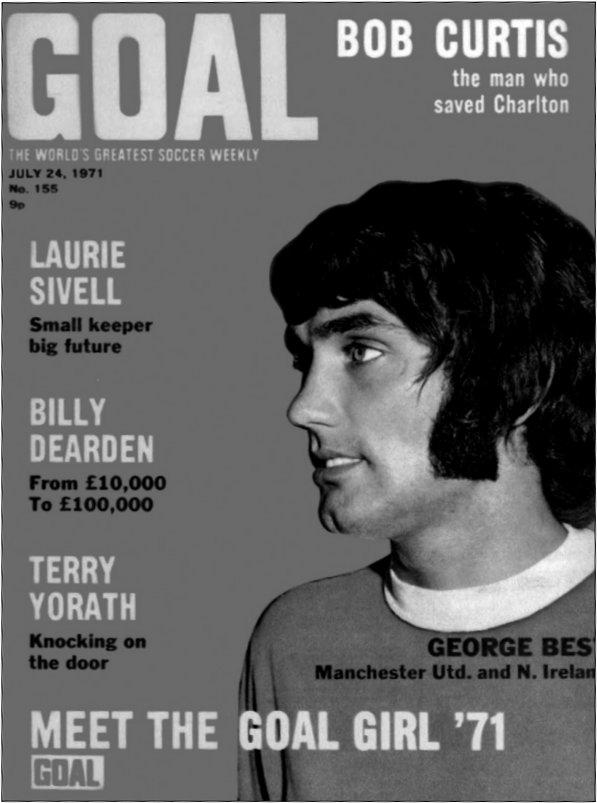
Anyone who knows football will know the name and the myths surrounding this magician of a player. I won’t launch into an extended eulogy on how good he was – these are numerous from team-mates and opponents alike, especially this week – I will just say that coming from the British Isles we have never produced a more gifted footballer and that, if we can transcend borders for a second, he is one of the greatest players of any nationality ever to pull on a pair of boots. That he pulled these boots on for Northern Ireland, however, meant that getting to a World Cup Finals, which during his career only accommodated sixteen teams, was a monumental task.
George made his debut for Northern Ireland against Wales in 1964, the same day as another debutant, the outstanding goalkeeper Pat Jennings. Unfortunately, these were the only two players in that team of international class. For Best there was no outfield player to act as a foil, no one remotely like a Didi, Garrincha or Tostao afforded to Pelé, not even a Valdano, Burruchaga or Cannigia that aided Maradona. Compared to the other home nations, Northern Ireland were very much the poor, distant cousins, memories and heroes of that epic run in 1958 now slipping away, but how quickly that can change with a genius in your team. In the qualifying cycle for the 1966 World Cup in England the Northern Irish played above themselves, the teenage Best inspiring them to a position whereby they only needed a win in Albania to qualify for a play-off with Switzerland for a place at the finals.
And they blew it. An awful 1–1 draw in Tirana ended their hopes and sent the Swiss through to the finals by a point, an utter disaster of a result with the World Cup waiting just over the Irish Sea, in stadiums the players knew so well and that Best was starting to illuminate. As if to prove what a loss he would be to the tournament, in the spring of 1966 Best turned in perhaps his greatest ever performance, scoring twice for Manchester United in a 5–1 European Cup victory over Benfica in the Stadium of Light, the Benfica of Eusébio, European Cup finalists in four of the previous five seasons. Best was christened ‘El Beatle’ and the legend grew and grew until it inevitably spiralled out of control.
The qualifying cycle for the 1970 tournament in Mexico put the Irish in a tough group with Turkey and the USSR. When the qualifying started in 1968 Best was at the very apex of his powers – Footballer of the Year in England, winner of the Ballon D’Or for the best player in Europe and in the May of that year scored perhaps his most famous goal which effectively decided the match as Manchester United finally won the European Cup 4–1 against Benfica. He was so far removed in terms of ability from his international team-mates at this stage he may as well have worn a different kit.
Certainly other teams had marked him out, Estudiantes showing the roadmap to dealing with Best by kicking the living daylights out of him in the Intercontinental Cup Final. With both the Irish and USSR brushing Turkey aside they essentially contested a two-legged play-off to reach Mexico. The teams fought (literally) to a stale-mate in Belfast in September 1969 and one month later met for the showdown in Moscow. Crucially Best was out injured, with him went the hopes of Northern Ireland and inevitably the Soviets won 2–0 to qualify.
And so the dream was over. He made sporadic appearances in the 1974 and 1978 qualifying tournaments but these were as infrequent as his appearances were becoming in club football. Having first quit football in 1972, Best’s career and life went into a steady decline and he would never be the player he was again. Like Garrincha and Maradona, his fall from grace was at times sad, tragic, and horrifying, but when you fall from that height it is a long, long way down. Northern Ireland finally made it back to the World Cup in 1982 whilst 37-year-old Best was going through the motions with AFC Bournemouth. One of the stars for them in Spain that summer was a 17-year-old prodigy called Norman Whiteside, a Manchester United youth player discovered by Bob Bishop, who a generation earlier had sent a telegram from Belfast to Matt Busby with the legend ‘I think I’ve found a genius’ upon his sighting of one George Best.
So is he the greatest player never to play in the World Cup? Probably. Maybe. Oh what the hell, definitely. Sorry, Mr Di Stefano, but I’m planting my flag firmly in the Best camp. Of course it’s personal bias, but my choice is made on what I have seen of both players from the archives, and other than Diego Maradona I have never seen a player with so many weapons in his armoury, so many options of how to beat his opponent or quite simply the capacity for me to jump out of my seat in amazement.
He reminds me why I love football so much. People will continue to dwell on his self-destructive nature that curtailed his career and eventually his life so early, but to paraphrase the man himself, they should remember the football. And what football it was. That he never played in a World Cup is not his loss, it’s ours.
Acknowledgements to Planet World Cup webpage where this article first appeared.
MORE THAN JUST A GAME OF TWO HALVES
For those of us that have experienced those unspeakable feelings of seeing the winning goal brush into the goalmouth netting with that delightful, almost echoing ‘whooshing’ sound during the final minute of extra time; or indeed the reverse feelings of wretchedness as the opposing side are awarded and execute a penalty kick that wins them the game – have you ever wondered just what it is that touches our emotions in such a way?
That, of course, is from a fan’s perspective, but what about those on the pitch? Why do they act and react the way they do? Why do some managers strut the technical area shouting limitless instructions, and on occasions provide the crowd with war-dance tendencies, when other managers, chewing their favourite gum with arms strategically folded, lean against the dug-out stanchion following every move of every player?

Why do fans become tribal when they enter the football ground?
Then again, why is it that usually dignified human beings become chanting, outspoken, demonstrative beings, and players who are normally shy, reserved and non-challenging citizens become war-like when in their club’s strip, part of a team kicking a ball around a piece of grass? What happens? Is there some kind of metamorphosis that takes place when either fans pass through a turnstile, or players and managers make the transition from dressing room to football pitch?
If, as Karl Marx suggested, ‘Religion is the opium of the masses’, and football undoubtedly takes on religious proportions, can we then suppose that an intoxicating tribal mentality can also be intrinsic in all associated with the game of football?

‘Some people think football is a matter of life and death. I can assure them, it is much more serious than that.’
Bill Shankly
‘Some people think football is a matter of life and death. I can assure them it is much more serious than that’ is a famous quote from the great Liverpool legend Bill Shankly, but are we really to believe that football is anything more than simply ‘a game of two halves’?
If, as some would suggest, Britons everywhere are elevating the beautiful game to religious status, then are the players to be described as gods, the stands as the pews, and the football songs passionately sung by tens of thousands which can be heard for miles around as hymns?
Football provides the ritual for weekend and sometimes weekday evening gatherings for the truly committed. To actually see first hand thousands of people singing their hearts out, hands held high to, in their opinions, greater beings is quite an emotional experience.
Football clearly demonstrates the tribalism associated with religion. It brings together the young, the old, the rich and the poor. It even has its fundamentalists, the hundreds of foolish hooligans that think violence is the best illustration of their devotion. Whatever the comparison, football engages people in a mass emotional display of their selected ‘faith’.
In 1977 Desmond Morris became a director of a professional football club. As Desmond is a student of human behaviour, he became fascinated by the way a simple ball game had risen to become the 20th century’s most widespread and popular sport. In his book The Soccer Tribe, he writes about football as if he were an explorer visiting a fascinating native tribe for the first time. He suggests that those involved in football, including players, managers, directors, officials, supporters and fans, have rituals and beliefs just as remarkable as those of any remote culture on a far-away island.

Desmond Morris, author of
The Soccer Tribe.
Morris explores the idea of how football players are ‘shaped’ and become tribal heroes. He looks at how football has shifted from players once coming from affluent public- school backgrounds to when the game became a profession and was rapidly taken over by the industrial world of Victorian England. He suggests that ‘The factory workers filled the grandstands and it was their sons who performed on the pitch.’
Most of today’s great stars kicked their first football in a back alley or a side street. As Pelé recalled, ‘Our field was the street where I lived… and our goals were the two ends of the street… Our sidelines were where a kerb might have been had the street been paved.’ Equally Danny Blancheflower would ‘kick a ball at every opportunity in the streets of the housing estate where I lived, in the school playground, under the railway arch and beneath the lamp-posts on dark evenings’.
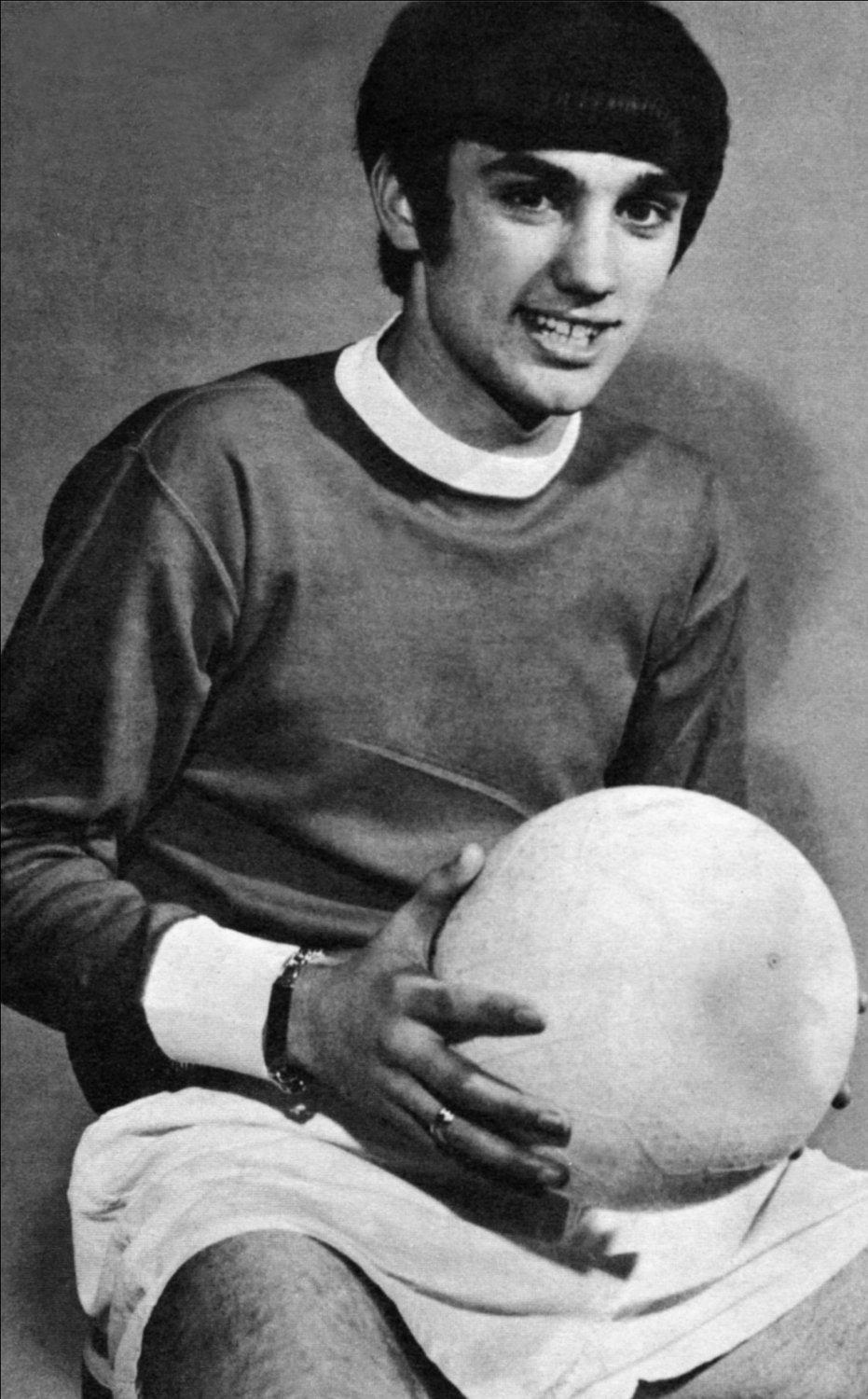
Young football superstars nowadays have support and advice – these were not readily available when George became the first footballer to become a celebrity.
The passion became so intense that small boys became ball-jugglers and appeared to be magicians of leg movement and balance, with the football becoming almost a part of their anatomy. As George Best said, ‘In those days when I was a kid the only thing I shared my bed with was a football. I used to take a ball to bed with me. I know it sounds daft but I used to love the feel of it. I used to hold it, look at it and think, “One day you’ll do everything I tell you.” I only lived for football.’
But it’s not all about being a ‘tribal hero’, the personality of these ‘heroes’ have to incorporate competition and cooperation. Morris suggests that, ‘The role of tribal hero involves basic conflict. To succeed he must be intensely competitive, but he can only achieve success by behaving cooperatively as a member of a team.’ So our football player must be aggressively self-centred and to some extent egotistical while also being self-effacing and helpful. Morris explains, ‘This fundamental contradiction goes a long way to explain the personality of the modern soccer player.’
And of course it’s not only players and managers that have tribal characteristics. Mark Dowd, a television football commentator and lifelong Manchester United fan, investigated the question of the religion of football in a Channel 4 documentary Hallowed Be Thy Game. He interviewed players, managers, fans and religious authorities and others in a programme packed with footage that captured the fervour the game inspires all over the world. His film showed how the ritualisation of football not only echoes that of religion but also increasingly converges with it. A Portsmouth fanatic whose home and tattooed body are shrines to his club told Dowd: ‘It’s not just a religion, it’s a way of life.’
For Dowd, ‘The passion for football builds on a void at the heart of our existence in a society of fragmenting communities, where more people live than ever before… The sheer power, noise and rhythm of the crowd, I can both marvel and yet feel a deep unease. That which grips man’s soul has the potential both for enormous good, and yet can unleash tremendous tribal violence.’
Desmond Morris suggests: ‘In essence, then, the personality of the soccer player must contain a lust for victory that is powerful but controllable. There is no question of “art for art’s sake” – playing for the fun of playing… His professional world is one of ambitions and those seeking of rewards – the winning of glory, money and status.
‘To satisfy these aims, the player must have inherent toughness of character and a strong romantic streak. Publicly, he must be down-to-earth, even cynical and self-mocking to protect himself from ridicule, but privately he must dream of glittering prizes and great triumphs. He must have a powerful ego, but one that is prepared to suffer to achieve its goal – in both senses of the word.’
It would be interesting to unearth plenty of other unions between football and religion: the Catholic–Protestant hostility that taints Rangers–Celtic matches; the fact that many funeral directors now sell coffins in team colours. What would a 21st century Marx make of it? Regimes, dictatorships especially, including religions, have seized on football’s potential to divert attention from divisions dogging their society. For example, the Brazilian team unifies the nation more effectively than the Catholic Church. If religion as Marx perceived it, stripped of its spiritual trappings, is little more than a powerful agent of social control, he’d probably say that football functions are effective substitute.
Football is tribal. The smaller tribes are clubs; the larger, nations. Football can unite us more than it can divide us, and today’s beautiful game can also channel tribal emotions along peaceful paths.
It doesn’t matter the colour of your skin, where you come from, your political ideology, your educational background, even your primary religion; football belongs to every person. ‘The great thing about football is that it can attract the sort of emotion and passion that becomes a sort of religion in people’s minds,’ says Manchester United boss Sir Alex Ferguson.
So how can we account for what happened to one soccer tribe hero and genius, George Best? It has been recorded and stated many, many times that he was football’s first superstar. George said himself that what happened to him off the pitch had never happened before, no one really knew what to do or how to deal with all that his stardom entailed. And so George was metaphorically left to the devices of wolves, in whatever form: the press, ‘friends’, money, women, lifestyle and in the end alcohol.
Unlike Ryan Giggs who, according to Giggs: The Autobiography by Ryan Giggs and Joe Lovejoy (Penguin Books), ‘is comfortable with fame because, from an early age, he was sure it would become part of his life, he prepared for it. When he was a child he used to practise his autograph… he had always had an ambition to be on the cover of GQ magazine… With preparation like that, when fame arrived, he wasn’t surprised or wrong footed by it; and now it’s attached itself to him.’
But not so for George Best! The genius of George was placed at centre stage with nothing and no one within the tribe who had either the foresight or the experience to put in place a mechanism to protect him. He made many mistakes and was criticised publicly for whatever he did. But, except for a few true friends, did anyone consider giving him the support he needed?
Was January 1974 when George finally handed in his United red shirt for the last time a time of reflection for him – or perhaps his own personal ‘half-time’? Perhaps the blushes he displayed during his brief encounter with the 14-year-old fan Mary at Manchester Airport (see page 140), when she approached him for his autograph, was truly a part of his musing on releasing himself from the tribe that he had been a part of for 11 years.
Desmond Morris theorises some of the tribal pressures encountered by those within, such as tribal territories, taboos, strategies, tactics, gatherings, the central rituals of a tribe and so on – but George Best experienced all of these tribal pressures, and far more.
Consider, just for a moment: did George Best realise at the end of the European Cup Final, even with all the euphoria, the delights, the celebrations, that he could go no higher within this tribe? He didn’t join in the festivities of the evening following the record-breaking win, he went off somewhere on his own. Did the tribal pressures cause him to just want to escape it all at some point, and was part of that escapism his reported womanising, clubbing and drinking? Was it in 1966 after the Benfica game that he first became that tribal god? Were the elders in the tribe getting just too old to go out and battle on the green turfed war-zone, but not have the experience of super-stardom to pass on any words of wisdom to the younger tribe members? In the Northern Ireland tribe, were the other members of the tribe lacking enough skill to work and battle along with the Best?
Desmond Morris suggests ‘The Tribal Hero’s attitude to sex involved the classic double standards. When he marries he is typically a loving husband who cares deeply about his wife but, when some players are single, they tend to treat girls like crude sex objects, to be bedded as quickly and as often as possible.’
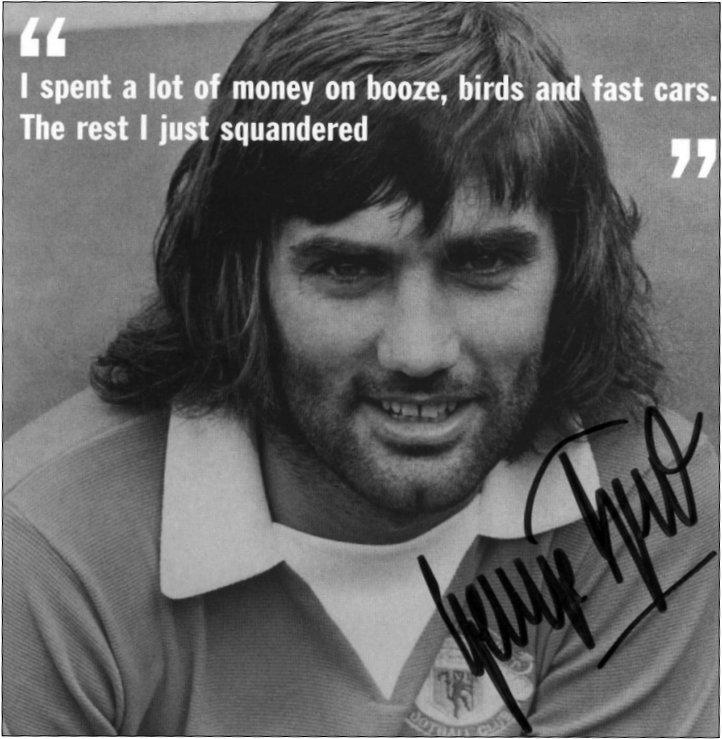
So the handsome, fashionable, fine figure of a 1960s guy, George Best was not only a ‘Tribal Hero’, he was also a sex god to many. His only complaint about the easy availability of sex was that, in the end, it became too much for him: ‘It got on my nerves. I’d open my curtains in the morning and there would be a line of young birds looking through the window… It was incredible. I never had to take them out to dinner or any of that crap. They’d ring me up or hang about the boutique and straight upstairs… They used to fall over themselves to get into bed with me… I know a lot of them just did it to say they had slept with George Best… just as they were going to climb into bed with me they’d say, “I hope you don’t think I’m doing this just because you’re George Best…” I didn’t mind so long as I enjoyed myself.’ Was George Best’s exit from the United tribe a time for him to shut the curtains on the tribal groupies awaiting their tribal god to choose them or had it, in the words of the hotel porter, ‘all gone wrong’? The offer from the United States gave George the opportunity to be a part of a new tribe and did George need the offer to try to reinvent the warrior within himself?
Today’s highly organised game does not merely channel tribal-national emotions into relatively peaceful paths, with clear limits, well-enforced rules (on the pitch, at least) and handshakes at start and finish. Now, any fame or stardom that goes unprotected is taken very seriously and, if an individual is left to fend for himself, it can have a detrimental effect on his life. It has put in place the much-needed – but all too late for George Best – mechanism to protect those extraordinary individuals who transcend all barriers and become true world stars, but who are, more often than not, just young lads off the streets where they were brought up, who just want to play football.
Dunstable Town
August 1974 – October 1975
12/8/74 v Cork Celtic
5/9/74 v Manchester United Reserves
(won 3–2, George was mobbed)
29/10/75 v Luton
(New Floodlights)
| Appearances | Goals |
| 3 | 0 |
THAT’S WHAT FRIENDS ARE FOR!
‘When he’s off the booze he’s a wonderful guy. He’ll do anything for you’ was the heartfelt comment of 28-year-old Barry Fry when he was player-manger at Dunstable Town F.C. in 1974. And that’s exactly what George Best did: Best did his best for his old Manchester United team-mate Barry Fry.
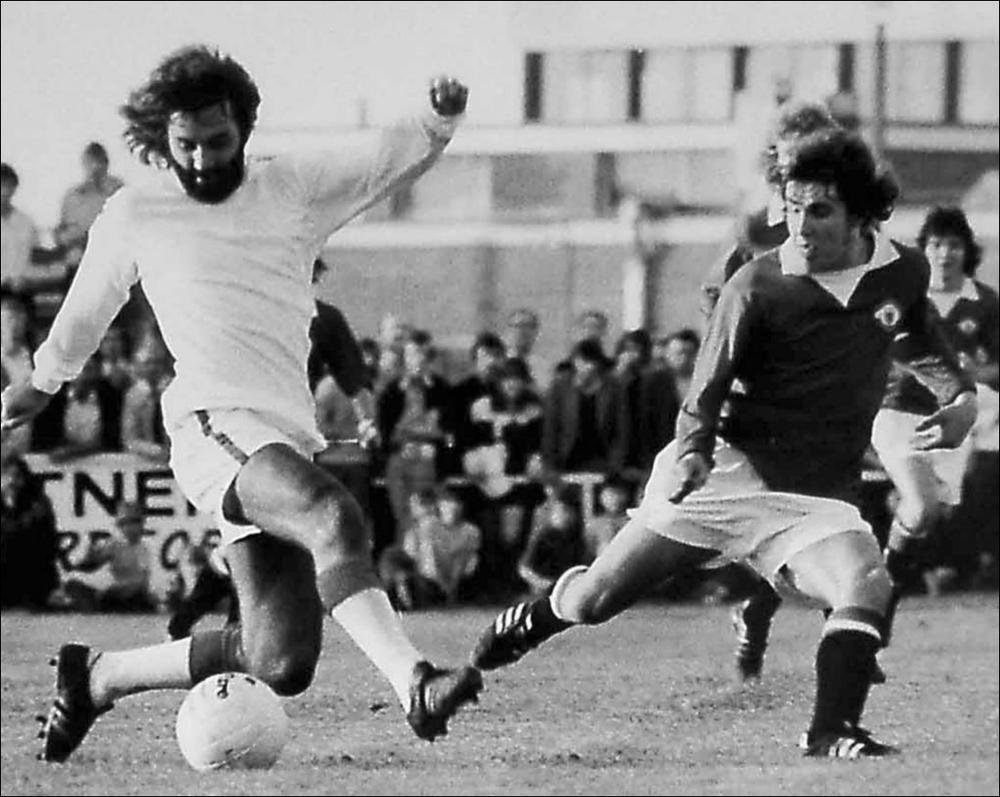
George hadn’t really done anything football-wise since February of that year; in fact, Julie Welsh in the Observer, July 1974, suggested that ‘football had been granted an unconditional divorce from George Best’. So why had George decided to reunite with the love of his life – football?
In simple terms, he was helping an old friend out, someone who had been given the job of managing and playing for Dunstable Town F.C. and who, under a new chairman Keith Cheeseman, had been given the job of putting the club on the map.
Barry had been on the books of Manchester United just a short time before the genius of George had been spotted in Belfast and subsequently signed by the mighty reds. Barry Fry recalled that the happiest legacy of his time at United was an enduring friendship with another youngster who out-dazzled even the bright lights of the big city.

One of the programmes from when George turned out to help his friend Barry Fry at Dunstable Town F.C.
‘I’d been there a year when Bestie came, and he soon leap-frogged me. He was obviously a genius. The lads used to moan in training because he’d beat six men, then go back and beat them again, but Matt Busby and Jimmy Murphy said, “Leave him alone, he’ll learn to pass” – which of course he did.’
When Fry commenced management with humble Dunstable Town in the Southern League, he invited George Best to make a guest appearance. ‘George was still with United, but he’d fallen out with Tommy Docherty and was refusing to play. When I told Tommy Doc that he had agreed to play for Dunstable, he said, ‘Right, I’ll bring a team down and you can play against us.’
Barry’s first match as manager of Dunstable Town had been played in front of 34 spectators. For the next match, 43 turned up. But, when George Best played against a Manchester United XI, amazingly Dunstable’s gate exceeded 10,000. ‘That put us on the map. Then we signed ex-West Brom and England centre forward Jeff Astle and, having been bottom of the league for nine years on the trot, we scored 105 goals and won promotion. George has been a real good friend to me.’
On Wednesday, 29 October 1975, the match, Dunstable Town F.C. versus Luton Town F.C., celebrated the official opening of Dunstable’s new floodlights. The programme on the night featured the late, great George Best guesting for Dunstable. On page 3 of the programme Barry Fry wrote: ‘I welcome players, officials and supporters of Luton Town F.C. and would like to take this opportunity of thanking Harry Haslem and his Directors for sending his 1st team to officially open our £10,500 floodlights. I also welcome George Best back to Dunstable and thank him for guesting for us once again. I am sure that everyone is in for a very entertaining evening with plenty of goals…’

George and Tommy Docherty had fallen out.
Some may say that that’s what friends are for, to call upon in a time of need. For Barry Fry and indeed Dunstable Town F.C. it meant far more. Barry said of George, ‘How can you put into words what it means getting George Best at Dunsatble? It’ll be a bigger boost for the club than having Frank Sinatra sing at half-time.’
For Dunstable in 1974 something far better than having Old Blue Eyes happened, the brown-eyed genius – who may have been edging towards the end of his footballing career – made just three appearances as a favour and in support of an old mate. As Barry Fry said, ‘He’s a wonderful guy. He’ll do anything for you.’ And he was right, George didn’t let him down.
MARY’S STORY … MEMORIES OF MR ‘G’
In March and April 1974, George Best was living through the nightmare of being accused of stealing Miss World Marjorie Wallace’s fur coat. He had received £2,000 conditional bail not to contact Miss Wallace directly or indirectly, to which the magistrate said, ‘Well, he would have a job to do that. We can’t contact her ourselves.’
George kept bail conditions and was accompanied to court by his friend Michael Parkinson in April. He was cleared of the charges of stealing property from the flat of Marjorie Wallace. Although Miss Wallace didn’t make any court appearance, George made three and Mr Kenneth Harrington, the magistrate, told George, ‘You are dismissed and I think I should add, as this matter has received a good deal of publicity, I should emphasise that you leave this court without a stain on your character.’
It was with all this behind him that George happened to be at Manchester airport – as was 14-year-old Mary who was living in Willenshaw at that time. George was obviously waiting for a flight, but the airport was the place that Mary and her friends would often be found hanging out on weekend afternoons. They used to do a spot of people-watching and dream of far-away places like the United States and Las Vegas – imagining boarding the plane and being waited on as they flew off to some exotic destination. The airport was also the place to get a tasty cup of hot chocolate from the vending machines!
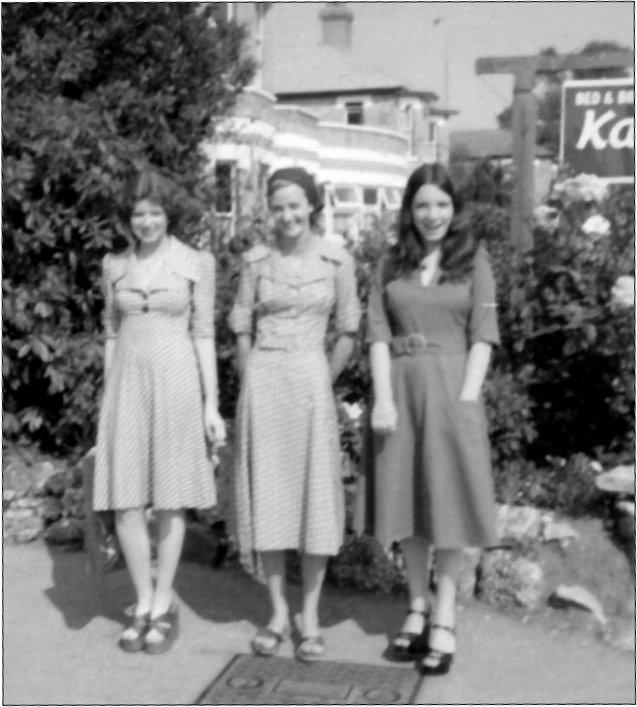
Mary and her friends used to like hanging out at Manchester airport.
It was on one of these afternoons in May 1974 that Mary and her friends spotted George Best waiting in the airport. Being Irish herself, even at the tender age of 14, Mary was so proud of George and how he had literally put Ireland on the international map, and she had seen him play and display his talents at Old Trafford over the past two years.
Mary wanted so much to go over and ask George for his autograph, but her friends didn’t think it was a ‘cool’ thing to do. Although usually a very shy person, Mary felt so confident that her Irish countryman wouldn’t shun her that she calmly walked up to him and asked him for his autograph.
Mary was so surprised at George’s shyness and how he even blushed. Unfortunately for Mary, she had a pen but nothing for him to write his autograph on – so George took from his pocket a takeaway menu from a Chinese restaurant and began to sign his name. The pen didn’t work! George managed to write the letter ‘G’ but that was all. Now blushing even more and almost stuttering George apologised and gave Mary the menu for keeps.
Mary went back to her very jealous friends with the ‘G’-signed menu that she kept in her memory box alongside other precious things such as a letter from her first boyfriend and another letter from her mum when she first left home. She kept that menu for years and only recently threw it out during a mega clear-out – but the memory of Manchester airport in May 1974 still lives on.

Young Mary treasured her takeaway menu bearing George’s initial!
The court appearances relating to Miss World’s fur coat had caused George to be humiliated and it had embarrassed him; it had inconvenienced him and subjected him to adverse publicity.
The embarrassment of the dried-up pen stopping him making a 14-year-old girl’s day in Manchester airport later on in that year would not have been the same for sure. Even without the autograph the pen had stopped him from writing, George was able to make memories for his fans and supporters – such things never made the headlines but are kept in the archives of the memories of many.
Jewish Guild
May 1974 – June 1974
| Appearances | Goals |
| 5 | Goals not known |
GEORGE’S SOUTH AFRICAN JOURNEY
In 1974, George Best played as a guest for the Jewish Guild F.C. in Johannesburg. He did so as part of a lifestyle that included playing a total of five games for the club and drinking, gambling and living the high-life – he was allegedly paid mega-bucks for the privilege. Not much is recorded about George in South Africa, but we do gain some insight into his time there in a tribute article written by Sy Lerman for the Mail and Guardian online newspaper around the time of George’s death:
BEST WAS ‘BASICALLY A SHY PERSON’
Sy, Lerman Johannesburg, South Africa
26 November 2005
The image of soccer genius and legend George Best as a compulsive extrovert and womaniser was refuted by two South Africans who knew the soccer genius and legend better than most.
Best, who died on Friday (25th November 2005) at the age of 59 of a lung infection to his alcohol-ravaged body, which had required a liver transplant four years ago, played several games as a guest for Jewish Guild in the old National Football League in the 1970s.
He was described by former South African and Highlands Park midfielder Martin Cohen as ‘coming from the salt of the earth – a very rare player and a very rare human being’. Cohen played alongside the Manchester United icon when they were both with the Los Angeles Aztecs in the United States in 1977.
‘He was basically a shy person behind all the glitz and publicity,’ said Cohen, ‘and cultivated the outspoken, bravado image and sharp tongue as a tool against what he perceived a cynical, unprincipled media whom he despised. I remember the phone ringing once,’ said Cohen, ‘and the caller announcing himself as John Smith of the Sun. “This is George Best of the Earth,” replied Best, “so just f*** off.”’
Cohen said women flocked to Best like moths to a flame – ‘but it was not because he chased them. Rather, it was because he was so good-looking and had such a magnetic personality they found him irresistible. I met him in London five years after we played together in America,’ said Cohen, ‘and he treated me like a long-lost brother. That’s the kind of guy he was.’
Lawyer Itzey Blumberg, who was a director of Jewish Guild when Best played briefly for the club and who was his constant companion in South Africa, described him as a ‘gem – a very unique person’.
‘I owned a beaten-up old Toyota at the time, with the passenger seat only prevented from collapsing by an old hockey stick,’ reminisced Blumberg. ‘The Guild directors sent a fancy limousine to take George to the Rand Stadium, but he insisted on travelling in my jalopy.
‘He spent most of his time in South Africa partying and only showed his rare talent for the first 10 or 15 minutes of each game. But one shot from almost the halfway line at Balfour Park rocketed against the crossbar and was the best of Best.’
Blumberg introduced Best to controversial stripper Ultra Violet, who was one of his clients, and the pair raised more than a few sparks. ‘But he was never happier than in the privacy of his close friends,’ said Blumberg, ‘and I still cherish a vintage wine bottle we polished off together at one such meeting with a couple of friends.’
Through what appears to be an honest report of George’s time in South Africa, it isn’t difficult to see through all the drink, glitz, women and money to see that underneath it all George was still a normal guy with a terrific gift, and someone who people enjoyed being with.
Stockport County
November 1975 – December 1975
10/11/75 v Stoke
Friendly with 8000 fans
28/11/75 v Swansea
League debut. Scores. 9230 fans
12/12/75 v Watford
5055 fans
26/12/75 v Southport
6321 fans
| Appearances | Goals |
| 3 | 2 |
Cork Celtic
December 1975 – January 1976
League of Ireland
28/12/75 v Drogheda (H)
11/1/76 v Bohemians (H)
18/1/76 v Shelbourne (A)
19/1/76
Sacked for lack of enthusiasm
| Appearances | Goals |
| 3 | 0 |
SIMPLY THE BEST FOR STOCKPORT AND CORK CELTIC
In 1975, George Best signed with Stockport County, a Fourth-Division club that would be the equivalent of a single-A baseball team in the United States.
Still in the shadow of his reputation of being one of the finest footballers Britain has ever produced, George resumed his football career as he stepped out onto Edgeley Park for a fundraising game against Stoke City – incidentally, Stoke was desperate to sign George at t his time.
As you would expect from a player who had been off the top-flight scene for 20 months, George took things tentatively but occasionally produced some magical moments such as a fierce drive from 50 yards that dipped just wide of the post. He also displayed some exquisite passes and incomprehensible changes of direction – something he never lost.
George never lost his magnetism. The fundraising game attracted an 8,081 gate, almost four times the normal attendance at Edgeley Park.
It had been rumoured that George would play for Stockport in a league match against Swansea on 28 November. As the rumours came true it was reported that Stockport were extremely grateful that he was a part of the team on that day as they would have found Swansea too much.
The following article is from the Stockport County website and gives a clear idea of George’s return:
Roy Chapman was only manager of Stockport County for nine months, but he’ll always be remembered as the man who brought George Best, arguably the greatest footballing talent produced in the British Isles, to Edgeley Park.
It was November 1975, with the Hatters involved in a real battle to avoid re-election, that Chapman, amazingly, persuaded the Irishman to weave his magic before the Edgeley faithful.
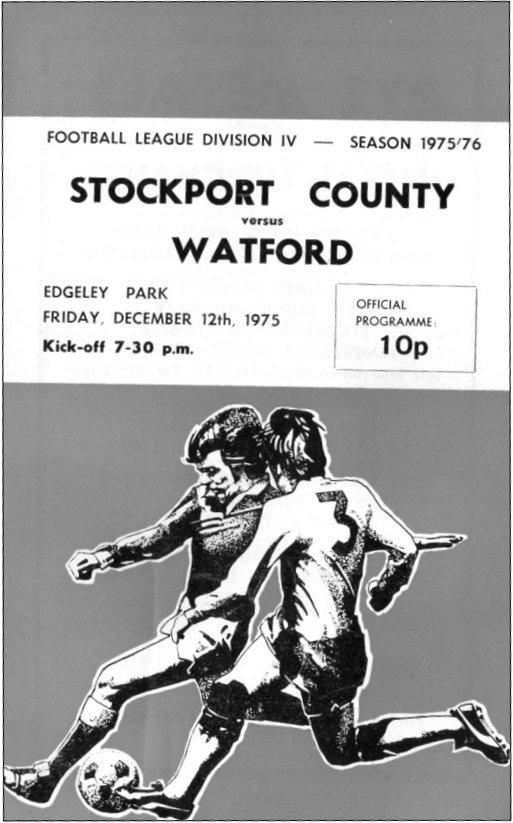
A crowd of 2,789 was present at Edgeley Park to witness a 1–0 defeat at the hands of Huddersfield Town in the previous home game before County crashed out of the FA Cup, 3–0 at next Saturday’s opponents, Hartlepool.
Without George Best, the attendance for County’s next game, against Swansea City on November 28, would have probably been under 2,000. With Best, the attendance was recorded at an incredible 9,240! And the mercurial Irishman didn’t disappoint the admirers.
19 minutes: County 1 Swansea 0
George scored with his third successive in-swinging corner from the left. The first two had the defence in such a tizzy that goalkeeper Steve Potter could only help it into the net.
55 minutes: County 2 Swansea 0
Best with heart-warming artistry beat three men, held another three off and glided the ball into the path of a young Lee Bradley to crash the ball past a now bewildered defence.
72 minutes: County 3 Swansea 0
The piece de-resistance! George started the move with a pass to Ian Seddon. The cross was headed on by McNeill, and Best, with his back to the goal, perfectly balanced, swung and volleyed the ball into the net with tremendous power. The noise from the crowd shattered the night air!
Swansea pulled back two late goals through Alan Curtis and Dave Bruton, but Best was not to be denied as County hung on for two valuable points.

The George Best bandwagon pulled in another 5,055 fans for his next appearance, against Watford on December 12, when another marvellous goal from the genius helped the Hatters pick up a point from a 2–2 draw. Another Northern Ireland international, Ian Lawther, was the other County marksman.
Best didn’t score in his final game wearing blue and white, against Southport, but his presence again attracted a bumper 6,321 crowd and also inspired Chapman’s side to a 1–0 victory thanks to a goal from Micky Hollis.
Without argument, one of the world’s greatest ever footballing talents had certainly put the club in the headlines and, although he was being well paid on a match-to-match basis, he must have kept the Hatters’ bank manager happy by pulling in over 20,000 supporters in just three appearances.
Without Best, County continued to struggle and they went into the final game of the season, at Scunthorpe, needing a victory to guarantee finishing outside the dreaded bottom-four. Anything less could see Swansea climb above them if they won at Rochdale.
Older fans will remember that Scunny used to kick off at 3.15 p.m. not the traditional 3.00 p.m. so County still had 15 minutes to play when news filtered through that the Swans had gone down 1–0 at Spotland.
The massive travelling army immediately burst into song: ‘Rochdale 1 Swansea 0, hallelujah!’
Knowing that County’s result at the Old Show Ground was now immaterial legendry keeper Alan Ogley got down on his knees to conduct the Hatters’ faithful who were now bouncing behind the goal!
Locals then watched on in astonishment as the final whistle sparked a huge party amongst the travelling hordes who had invaded the pitch.
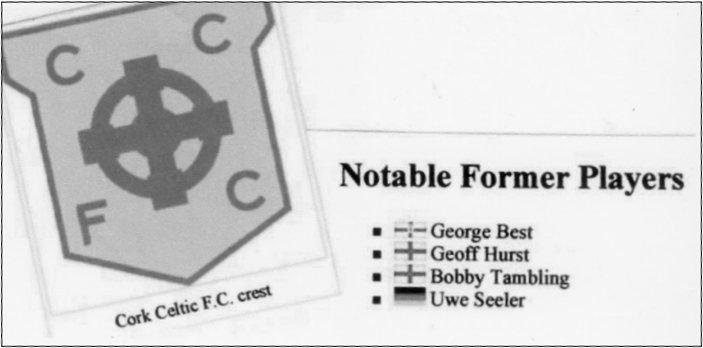
The following day’s News of the World reported: ‘At the end of the game hundreds of Stockport County fans invaded the pitch and from the noise they were making you’d have thought they’d just won promotion, not avoided re-election.’
The man George Best was back. Perhaps not fully fit and still with his unpredictable personality off the pitch, but nothing could take away his delightful talent – something Stockport was thankful for even if it was just for a short time.
Later, George played for an Irish club, Cork Celtic, and was let go after three games. Out of shape and 30 pounds overweight, he had become a parody of himself to serious soccer fans, but he still had the talent and instincts to dominate any football match he was a part of.
www.stockportcounty.premiumtv.co.uk
Fulham
September 1976 – November 1977
12/8/76
Signs contracts
2/9/76
Registered to play
4/9/76 debut v Bristol Rovers
Scores on 71 seconds. 21,127 in crowd
3/9/77 v Blackburn
12/11/77
Last game, lost at Stoke 2–0
29/11/77
Suspended for not training. He was in LA
| Appearances | Goals |
| 47 | 10 |
Los Angeles Aztecs
April 1976 – June 1978
Signed late December 1975
20/2/76 Arrives in the USA
17/4/76 Debut v San Jose Earthquakes
18/7/76 Hat trick v Boston Minutemen
20/5/77 First game of season v Portland Timbers
25/8/77 Last game of season v Seattle Sounders
2/4/78 First game of season v Houston Hurricane
20/6/78 Last game v Washington Diplomats
| Event | Appearances | Goals |
| Regular Season | 55 | 27 |
| Play Offs | 6 | 2 |
| Total | 61 | 29 |
Fort Lauderdale Strikers
June 1978 – July 1979
Transferred for LMA
24/6/78 debut v New York Cosmos
Scores 2 in 5–3 win
23/8/78 v Tampa Bay Rowdies
Lost, last game of the season
31/3/79 v New England Strikers
First game of the season, win 2–0
25/7/79 v California Surf
Last game of the season, away win 6–3
| Event | Appearances | Goals |
| Regular Season | 28 | 6 |
| Play Offs | 5 | 1 |
| Total | 33 | 7 |
San Jose Earthquakes
April 1980 – August 1981
13/4/80 Signs contract
27/4/80 Debut v Edmonton Drillers
Lost 2–4
1/6/80 v California Surf
Fails to turn up
23/8/80 v LA Aztecs (H)
Lost 2–1 but scored
29/3/81 v New York Cosmos (H)
Lost 3–0, first game of season
22/7/81 v Forst Lauderdale Strikers, 3–2 win
One of his finest games
19/8/81 v Vancouver Whitecaps
Last ever game
| Appearances | Goals |
| 56 | 21 |
EXIT UNITED – ENTER THE UNITED STATES
On 19 December 1972, Frank O’Farrell, Manchester United’s manager, lost his job. In a way it was the end of an era, with Bill Foulkes having retired, Bobby Charlton’s testimonial having been held the previous day and George Best retiring on that same day.
Tommy Docherty immediately began to rebuild the side with a series of signings, most notably Lou Macari. United recovered and finished that season in 18th place. George Best came out of retirement once more to sign with the team for the 1973/74 season. United were again caught in a relegation battle and entered the penultimate game of the season needing to win two games and for Birmingham to lose in order to stay in the First Division. Birmingham won their game and Denis Law, now playing for Manchester City against United, sealed United’s fate with the only goal of the game. Manchester United were relegated to the Second Division for the first time since 1937.

George with Elton John, who was part-owner of the club in LA.
1976 was a notable year in US ‘soccer’. While new names began appearing in many English club signings, favourite footballing heroes were taking the transatlantic flight to fame and sometimes fortune in the North American Soccer League. Rodney Marsh from Queens Park Rangers for US$80,000; former England captain Bobby More was enticed away from Fulham to San Antonio and, finally, Los Angeles, with new part-owner Elton John succeeded where New York had failed a year earlier, signing the elusive George Best – with George, just before his 30th birthday, being the youngest signing of the lot.
The American Bicentennial (1776–1976) was also being celebrated throughout the United States marking the beginning of their third century as an independent nation as well as the 200th anniversary of the American Revolution. Gerald R. Ford, President of the USA, stated:
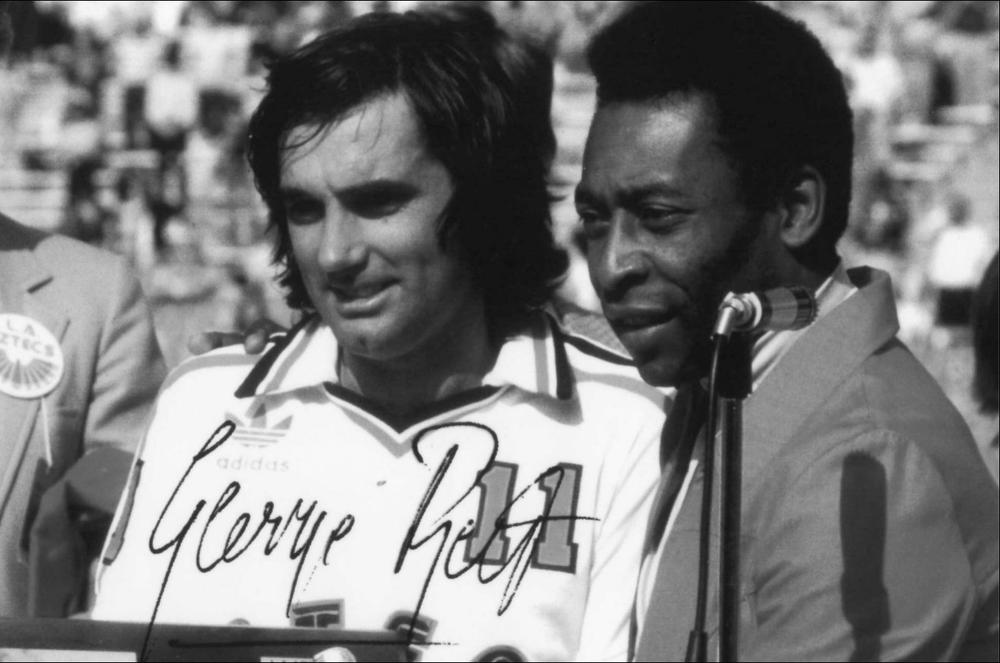
Two legends together – Best and Pelé.
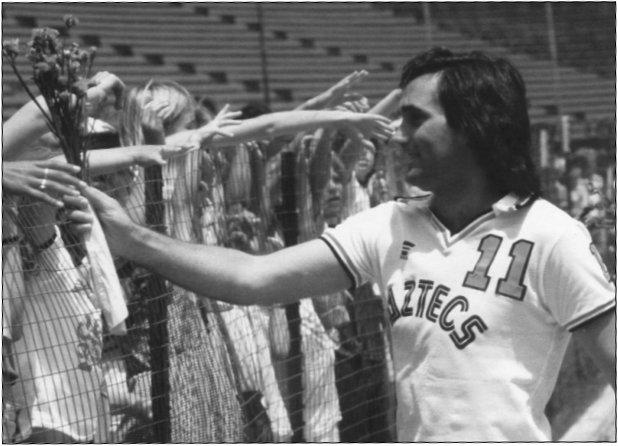
Aztecs 2: George turns out to the adoring crowd at the LA Aztecs.
‘For two centuries our Nation has grown, changed and flourished. A diverse people, drawn from all corners of the earth, have joined together to fulfil the promise of democrac… It is about the events of our past, our achievements, our traditions, our diversity, our freedoms, our form of government and our commitment to a better life for all Americans… Thus, in joining together all races, nationalities, and individuals, we also retain and strengthen our traditions, background and personal freedom… As we lay the cornerstone of America’s third century, I am most happy to commend the officers and members of the United States Soccer Federation and their Bicentennial Soccer Cup activities…’

The Bicentennial Soccer Cup was organised by the USSF to celebrate the United States’ bicentennial as a soccer tournament with three of the strongest national teams in the world: Brazil, Italy and England. It was intended to promote the game to the US audiences at large at a national level, and could easily have been called a mini World Cup; the Brazilians had won the cup three times, the Italians twice and England once. These three teams competed against an all-star team, called Team America. This was treated as a major event both in the United States and among the world press; over 500 media reporters covered the event.

Team America was made up of a mix of football stars from 12 countries included Pelé, Bobby Moore, Rodney Marsh, Dave Clements and, of course, George Best.
Unfortunately, Team America and the US audiences did not see the delights and skills of two of the players in this particular tournament, as, in a spate of last-minute politicking, George Best and Rodney Marsh demanded that they start all three games, when the coach, Ken Furphy, refused, they walked!

Although both of their names and photographs appeared in the red, white and blue souvenir programme of 1976, neither of them actually wore the red v-neck USA shirt. Who knows, may-be that could be one of the reasons why crowds averaging 45,000 witnessed Team America only scoring one goal throughout the tournament. Perhaps Ken Furphy lived to regret his refusal.

George with former wife Angie and their son, Calum.
Hibernian
November 1979 – October 1980
16/11/79 Signs for Hibs from Fulham
24/11/79 v St Mirren
Scores on debut in 2–1 loss, 13,670 attend.
9/9/80 v Dundee (A)
11/10/80 Final game v Falkirk (H)
| Appearances | Goals |
| 22 | 3 |
SCOTLAND WELCOMES BACK YESTERDAY’S HERO
On a weekend television show in 1979 George Best offered himself to any First Division club in England – not a bad way of telling the football world that you want to play football.
This offer, from such a talented and naturally skilful player, was too much to miss for Stewart Brown (the late Evening News writer) who suggested the idea of George moving North to Scotland to the Hibs manager, Eddie Turnbull. Hibernian were suffering the embarrassment of potential relegation for the first time in almost 50 years, and Stewart thought that even with George Best on the team the footballing disgrace couldn’t be prevented – but at least the attention would be sidetracked for a short time.
Eddie Turnbull thought it was a good idea and so the chairman, Tommy Hart, was brought in to the discussions. Tom was equally a supporter of his beloved Hibs as well as being chairman and responded really quickly to the suggestion of George Best being on the books.
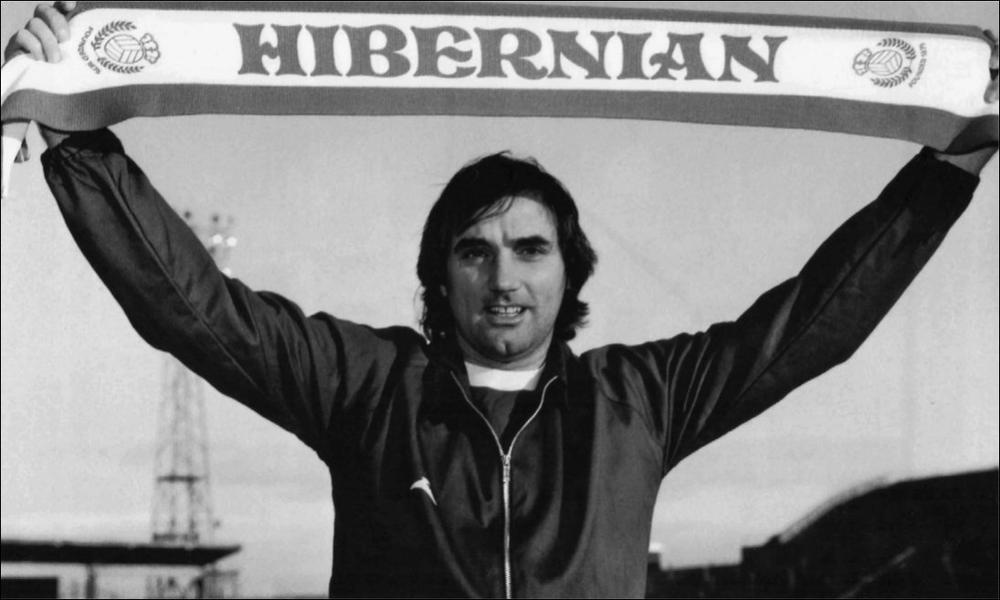
Demonstrating his new-found allegiance.
George had not long arrived back in England from the United States and was staying with his in-laws at Southend. He was still registered as a player at Fulham, so Hibernian had to seek permission from the club to talk to George. Within two days Hibs were talking with George and the agreement was made for him and his wife Angie to fly to Edinburgh to ‘have a chat’ and still be in time to watch the home game against Kilmarnock. Tom Hart met them at Edinburgh airport. But following lunch, as George made his way into the directors’ box at Easter Road, over 5,000 fans welcomed him into their stadium.
Eventually, George Best became part of the dressing room at Easter Road and the celebrity image was looked on with caution by his fellow players – particularly as they thought George was on £1,500 a match, funded personally by Tommy Hart. Hart defused any backbiting by doubling the bonus system the players already enjoyed.
One of the team, Tony Higgins, said at the time, ‘We’d heard some rumours that a big name was coming but it was only when George arrived that we believed it. But despite his reputation, George was a very quiet guy; there was nothing fancy about him. He was down to earth, a professional football player like ourselves.’

George was still officially a Fulham player when he returned to the UK.
George quickly became one of the players but it soon became quite evident that his life was poles apart from the lives of his new team-mates. While others had comparatively normal lives, George would still mix with people such as Rod Stewart, John Lennon and Michael Caine – to name a few. His lifestyle was just so different.
Something that never changed while George was at Hibs was the fact that he was a crowd puller. Where they were used to crowds of around 9,000, some gates totalled 22,000 just because George Best was on the team sheet. Not only did George attract crowds on match days, but the press from other shores would gather outside Easter Road just to get a glimpse of the man himself. The interest the 33-year-old former superstar aroused was absolutely startling. One wonders if the world’s press would have been so stirred up if someone like Diego Maradona had just joined a Scottish club! The most ambitious transfer in Scottish soccer history was also proving to be the most intriguing, as Best arrived to an overwhelming welcome.
‘He’s turned up,’ shouted one pressman, obviously still not sold on the idea that Best was, in fact, ready to make his first competitive appearance on British soil for two years.
Best had to push his way through an army of photographers as he took his place on the pitch for the first time in Hibs’ green and white shirt, so reminiscent of the Northern Ireland jersey he wore with so much pride when he was in his prime.
The game against St Mirren is now in the history books. Best played well enough, scored a last-minute goal, came within inches of another, but still Hibs went down to a 2–1 defeat.
At the end of the game it looked as though the entire population of China had arrived. The corridor outside the away team’s dressing room was bursting at the seams as journalists jostled to get into position. Microphones, cameras and notebooks were at the ready.
The door opened slowly and George, the man who had seen it all and done it all several times before, blinked in utter astonishment. The barrage opened immediately and an avalanche of questions – some in broken English – cascaded down on top of him.
Was he happy with his performance? He thought for a brief moment and said, ‘I wasn’t entirely satisfied. Ask me again in about six games’ time and I will be able to tell you. You’ll never see the old George Best though. But I think I still have something to contribute.’
How did he feel? ‘Obviously I need to get match fit. I wasn’t going to run up and down the pitch like a lunatic in the first half and burn myself out. I had to play myself quietly. It would have been nice to have turned on the old style, but that wasn’t the game to do it.’
Was he nervous? ‘You can say that again! I said to my wife Angela before the game that I had butterflies. This is a new experience for me. It was worse than playing to a capacity crowd at Wembley.’
Did he enjoy the reaction? ‘The fans were fabulous. The chairman, Tommy Hart, told me there were only 6,000 fans at Love Street earlier in the season when Hibs played there. Almost 14,000 turned up for my debut match and that pleases me. It was good to see that the gate had more than doubled. I’m happy the fans still want to see me. I knew everyone’s eyes were on me in that game against St Mirren and that is why I was a bit nervous.’

George leads Hibs onto the pitch.
Did he still think he could play at the highest level even at 33? ‘If I can get back to peak fitness then I don’t see any reason why I can’t. My legs might not be so fast but my head still works, you know. I can still see moves before a lot of other players.’
George handled the questioning superbly and then stepped into a chauffeur-driven Daimler along with his Scottish-born wife Angela and was whisked off to Glasgow airport where he caught the next flight back to his home in London.
It was very clear in the early stages of the momentous Hibernian signing of George Best that it was well worth it with the crowds that turned up to see him display his genius talents on the park. Tony Higgins last saw Best before he had his liver transplant, describing his appearance as ‘dreadful’, and reminding him of another footballing legend Jim Baxter who suffered an early death due to his inability to resist the bottle.
Although an alcoholic, George still had the ability to have a laugh at himself. Tony Higgins recalls, ‘I remember playing Rangers at Easter Road when we beat them 2–1. In those days dark holes would open up on the terracing as fights broke out. George went to take a corner and the Rangers fans started throwing cans of beer at him. Rather than react, George picked one up, pretended to take a sip from it and put it down by the touchline. It defused the whole situation, they started clapping him for that touch of humour he had.’
When around 18,000 people turned up for Hibs match against Ayr, Willie Murray was booed when he ran out with the number 11 on his back because they’d all turned up to see George. The night before, French rugby captain Jean Pierre Rives had heard Best was staying in the hotel and insisted that he join the party. Best did so with a vengeance and was the last man standing, albeit with difficulty, at the bar the next morning. Hibs sacked Best but Hart relented within a week and Best would remember the chairman fondly. ‘Tommy was just like Sir Matt… always giving me another chance.’
Despite the gulf which existed in their lifestyles, team-mate Jackie McNamara and George Best became firm friends, so much so that he returned to Edinburgh to feature in the Easter Road star’s testimonial match against Newcastle United.
Jackie McNamara said, ‘George was a lovely, lovely man. There were no airs or graces about him. He was well accepted and got on with all the boys. There was no “Billy Big” about him, he wanted to be part of the dressing-room, although he was earning many times our wages.’ And McNamara believes Best should be remembered for his skill as a football player and the pleasure he brought millions of fans rather than for his well-documented battle against drink that ultimately took his life.
The cosmopolitan George Best was always prepared to share his French lotions and deodorants (£100 a bottle) with team-mates more used to carbolic soap. Gordon Rae recalls: ‘The whole team would queue up to splash it all over and we’d all go around smelling like George hoping some of his magic would rub off – with women at least if not on the park.’

The drinking binge at the French rugby party was another chapter in the sad decline of one of football’s greatest-ever talents, but there were still glimpses of what Best had been. Chairman of Hibs, Tommy Hart, who gave Best numerous chances, was later to admit he had covered up for his wayward star on each occasion by saying he was injured, photographs even being taken of him on the treatment table to confirm the story.
However, Best’s drinking was spiralling out of control and his absences increased. He managed only 13 league appearances, although Hibs did get to the semi-final of the Scottish Cup. They were thrashed 5–0 by Celtic and at one stage Bobby Lennox could be seen consoling a frustrated George Best as once again team-mates failed to read his passes.
Sadly, Best’s battle with the demon drink was all too evident to his new team-mates and, ultimately, it led to a series of showdowns with Tommy Hart, who once famously declared: ‘The marriage between George Best and Hibernian Football Club is over.’
In hindsight, everyone could say that they had known it would never last, and the day that was confirmed the assembled press were thankful that it had happened at all.
George Best’s career as a Hibs player may have been short-lived – but his time at Easter Road was as colourful as the rest of his life. Tommy Hart pulled off one of the greatest signing coups in Scottish football, snapping up the wayward former Manchester United and Northern Ireland superstar from Fulham. But in April 1980 George’s Hibs career stopped and his football career started again in San Jose.
But that wasn’t the last Hibernian fans were to have the pleasure of George Best’s company at Easter Road.
On the evening of Monday, 5 October 1981 a challenge match was played against George’s new club, the San Jose Earthquakes – the team he signed for following his stint at Hibs.
In the programme for the match, manager Bertie Auld welcomed the Earthquakes: ‘San Jose are the first NASL team to play at Easter Road and this is a reciprocal game for the one we played – and thoroughly enjoyed – in California at the end of last season.
‘Any team which contains George Best is bound to be a major attraction and I know that Hibs’ fans will welcome him back with open arms after his links with the club in the past two seasons.
‘George has been a marvellous player throughout his career and, even at 35, he can produce the magic that’s always associated with him…’
Also in the programme were extracts from George’s life story Where Do I Go From Here.
In the book he confessed that ‘I could never see why this important English club [Manchester United] should have any interest in some five-foot-tall weakling who had been rejected by a Belfast club [Glentoran].’ He admitted, ‘That was my game for Belfast [when Ireland beat Scotland 1–0 in 1967], showing them perhaps for the only time what the boy from Burren Way could do when the mood took him. People there still talk about it as the greatest individual performance in an international and it pleases me that I could give them something memorable.’
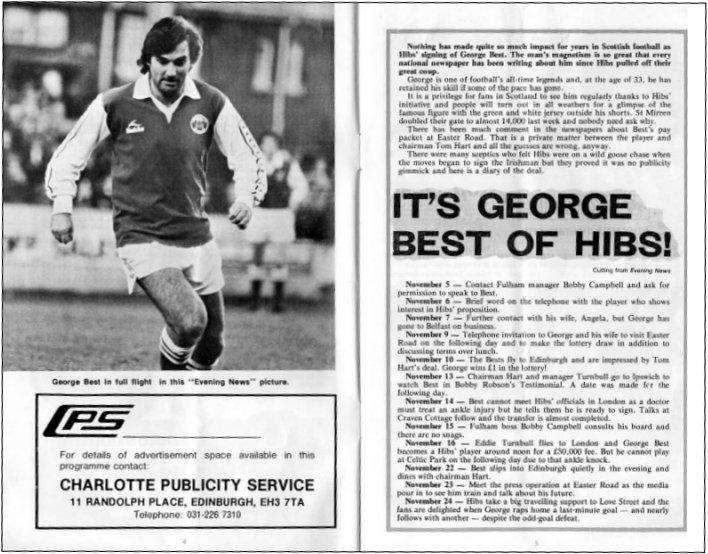
George Best’s journey during the early part of his thirties took him from the United States to Scotland and back to the United States again – but the thing that followed him wasn’t only his popularity, his skills and obvious talents on the ball, it was also the uncontrollable desire he had to have a drink. And once he gave in to that desire the drink became the master and the ultimate headline maker.
Perhaps in his own way George Best did learn to survive; survive between his own self-destruction combined with those that wallowed in his downfall. George wanted people to remember him for his football and, for those of us that really care, that’s what we do and will continue to do. George, when close to death, said that he had no regrets – we will just remember him.
SAN JOSE REMEMBERS GEORGE
Pelé’s presence in the North American Soccer League gave the whole set-up something it had always lacked credibility around the world. Suddenly, players who had snubbed the possibility of playing in the United States were queueing up to join the League. As a result, there was a sudden influx of top-quality signings not seen since the first American Soccer League’s heyday in the 1920s.
NASL teams, hoping that signing a Pelé-like superstar would boost attendance at home the same way Pelé’s presence had in 1975, opened their wallets like never before. Seattle Sounders signed striker Geoff Hurst from England, who scored a hat-trick in the 1966 World Cup Final.
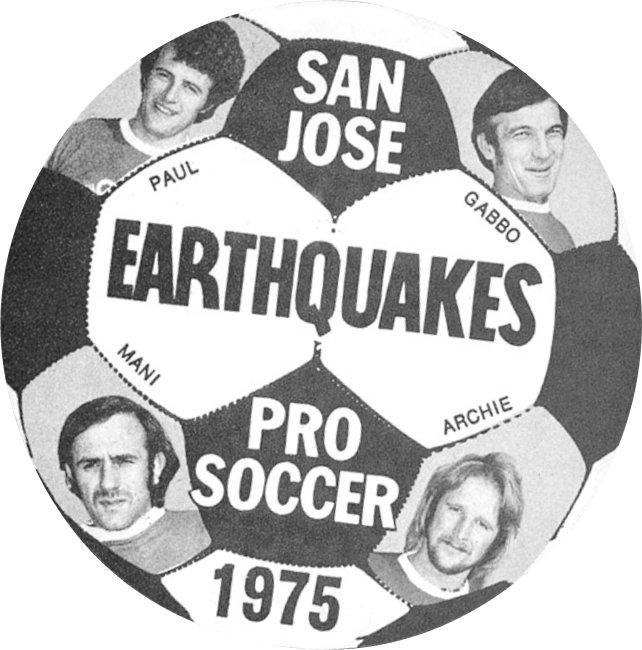
Still, some players came over with their skills intact. Tampa Bay purchased flamboyant striker Rodney Marsh from Queens Park Rangers for $80,000. Toronto signed Eusébio away from Boston. Ward Lay dipped into the family crisp firm’s fortune to sign former England captain Bobby Moore away from Fulham for San Antonio.
When George Best entered the US football stage, he had already won everything at club level in England and, by the time he reached the United States in 1975, Manchester United were top of the table in the old Second Division.
But what do the US football followers have to say about him now?
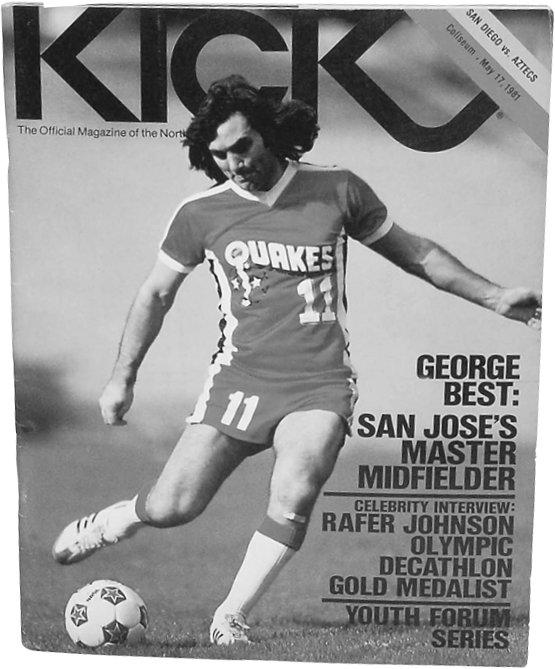
The last professional goal George ever scored was for the San Jose Earthquakes.
The following is taken with kind permission from the Metro Silicon Valley and was written by one of their staff writers as a tribute to George just a few days after the sad news of his death. Gary’s loose and laid-back style of writing has a fun tone to what he has to say, but the respect he and others had for George is present throughout the column inches he writes in honour to the Best:
BEST IN SAN JOSE
By Gary Singh
GEORGE BEST, one of the greatest soccer players in the history of the sport, is no longer with us. The Northern Ireland native passed away last Friday after almost two months of hospitalization. Even a controversial 2002 liver transplant could not stop him from drinking and he always said that alcohol was the only adversary he could never beat. He was right.
During his heyday for Manchester United in the latter days of the Swinging Sixties, Best was universally known as the Fifth Beatle and fans followed him wherever he went. Thousands of 14-year-old girls screamed whenever he touched the ball. The entire concept of the rock-star-millionaire-womanizing-boozing-sports-figure – Best practically invented it. There had never previously been such a flamboyant persona that combined a show business lifestyle with sheer genius on the pitch. He was the first and greatest rock star footballer. The chicks loved him and he did things on the field that no else could do. He was worshipped by millions. You think Dennis Rodman is an ‘outrageous’ celebrity basketball player? Well, Rodman couldn’t hold a punk candle to George Best’s antics in his day. Upon hearing of Best’s passing, Prime Minister Tony Blair even chimed in with a tribute from the road.
But if there was ever such a thing as a flawed genius, that would be George Best, and he was often lambasted for squandering his talent and his money over the years. He was quoted countless times as saying that he spent his millions on women, booze and cars – and that he wasted the rest.
By the time Best came to play for the San Jose Earthquakes of the old North American Soccer League in 1980, he was more than past his prime, but he still showed occasional flashes of incomparable genius. In 1981 he scored a near-impossible, bordering-on-frightening goal that people are still talking about to this day. He was called for a questionable foul and booked for verbally assaulting the ref afterward. Clearly angered… he took a pass and then went through six Fort Lauderdale players in 25 yards all by himself and blasted home the goal. He even beat one guy twice. Most who attended that match say it was the greatest goal they’ve ever seen, and it was the 1981 NASL goal of the year. For those of us who were at that game, we will never forget that goal, and he himself said it was the best one he ever scored.
Best was on hand when the first Britannia Arms opened up in Cupertino in 1981. In fact, he was usually in the bar 30 minutes before the games most of the time. The famous ‘George Best Pub Crawl’ took place whenever game time drew near and nobody knew where the hell he was. They had to go from bar to bar in search of the guy. Best will be remembered by many locals who are still left from those days, and he had many friends here. But that goal was the fondest memory for so many people. The goal was shown, among several others, in many newsreels after he died.
San Jose was also the place where his first marriage fell apart, due to alcoholism and adultery. In his second autobiography, Blessed, Best had this to say: ‘Even if [Angie and I] had a hope of sorting out our life together, it was not going to be in San Jose, which turned out to be the worst place ever for me, in just about every aspect of my life.’ He also says that San Jose is where he really hit rock bottom. ‘I hated San Jose and, although we had a nice house, which we filled with beautiful furniture, it was situated in the middle of nowhere. And while I tried to help around the house and get things ready for the new arrival [their son], I soon got bored and would head off on another bender… And nothing was going to stop me drinking, not even when Angie started hiding the car keys and all our money.’
Angie went on to write a book about it all and their son Calum, who was born here when Best played for San Jose, is now a famous model. After Best left the Quakes, he went back to the UK for the 1983 season, but that was it. The last professional goal he ever scored was for the San Jose Earthquakes.
Clearly, George is remembered with fondness and with honesty about this time of his life in the United States. Gary Singh is very proud to boast that he was ‘at that game’, in May 1981, the game where ‘that goal’ was scored. George may have been past his prime in those days and Gary himself was only a kid, but he and his mates will never forget that goal.

Gary Singh is also keen for those interested in George Best to know about Brandi Chastain who is one of the most famous US women’s players and is a San Jose native. She played in the kids’ game at half-time during the match where Best scored that goal where he went through six players. That experience solidified her decision to devote her life to football, and she mentions that game in her book.
Gary didn’t just write an immediate tribute to George following his death. He also used his column in ‘Silicon Alleys’ (Metro Silicon Valley) one year on from George losing his battle for life to remember him.
Columnist Gary Singh delves into the far reaches of the art, music and counter-culture scenes from Los Gatos and Saratoga to San Jose, Santa Clara and beyond. Each week,
Gary delivers a healthy dose of opinion, controversy and insight on the real and surreal. What a tribute to George that he used his column to ‘Give the Best’ to George:
THIS YEAR, GIVE THE BEST
By Gary Singh
Allow me to furnish some belated thanks now that the turkey day has passed us. George Best, one of the greatest footballers in human history, left this earth a year ago last Saturday. After a way-too-short career in Europe, the Northern Ireland native wound up with the San Jose Earthquakes during the 1980 and 1981 seasons. He died last year on the day after Thanksgiving, and on that fateful morning I stormed into the office and cranked out a last-minute obituary.

George enjoying life in the USA with the Playboy bunnies.
Best’s son, Calum, was born at Good Samaritan Hospital while Best played for the Earthquakes and, along with the greatest goal of his career, Calum’s birth was one of the few good memories of Best’s stint here. Given Best’s constant falling off the wagon, his then-wife Angie famously recalled the sequence of events that led to her to leave him: ‘Calum was a year old, I hadn’t seen George for a week and I was taking Calum to the doctor for a checkup. I’m driving down the street in San Jose, it’s raining – a really miserable day – and in the middle of the street, between the two yellow lines, there’s this creature walking towards me, soaking wet, miserable, huddled over like a homeless person, and I realized it was my husband. I looked at my son and thought: I can’t do this anymore. I can’t look after two babies. The big one has to go. And he did.’
Now, as I finish this missive on the day after Thanksgiving 2006, I must give thanks to Bestie for all the memories, especially that great goal in May of 1981 when he went past six defenders in 25 yards all by himself.
I was not the only one inspired by that performance, you see. A young girl named Brandi Chastain played in the kids’ game during halftime at that match and scored a goal herself. Listening to the crowds cheer afterward, along with witnessing Best drive home that now legendary goal, is what cemented her decision to devote her life to soccer.
‘When I started playing soccer, I had no role models to inspire me on the field,’ she wrote in her book, It’s Not About the Bra. ‘No one in my neighborhood, or in my family, played the game. But the very first time I saw the professional team that would become my guiding light, the San Jose Earthquakes, I found my role model. He was George Best, and in my mind, the name fit. Watching him corkscrew bewildered defenders into the ground with his amazing moves and a smile on his face, I said to myself, That’s what I want to do.’
Anyway, back in the ’60s, Best vaulted to worldwide stardom as a teenager and, according to Phil Hughes, his manager, Best was never allowed to own his own life ever since. He was constantly thrashing it out with pesky, irritating reporters who hounded him. Whenever he got into a barroom brawl, the media were right there looking for stupid sensational material to feed on. In Scoring at Halftime, Best recalls a holiday in Cyprus where he became ill, only to have reporters track him down in his hotel room. They wanted to hear that he’d fallen off the wagon again or, even better, if he was dying. They just weren’t satisfied that he had a simple virus. The hospital administrator then showed up and told him the reporters wanted to know if he was HIV-positive. Best said, ‘Tell them, yes, I am HIV – heavily into vodka. That’ll shut them up.’
There you have it. Why Best isn’t in the San Jose Sports Hall of Fame, I’ll never know.
The general opinion in the United States was that he was a flawed genius and that they took for granted how lucky they were to actually have seen George play in person. He may have been ridiculed for having to wind up in San Jose after having been on top of the world, but, for those that were fortunate to have seen him play, they ‘were blessed’.
WHEN A HERO COMES ALONG
When George Best tells his own dramatic and inspiring story in Blessed the blurb explains that ‘George Best was blessed with an extraordinary gift; he brought beauty and grace to soccer never before seen. But he was unable to cope with the success and fame his genius brought and his life story is littered with tales of women, sex and, of course, drink.’ This was written a few years after his infamous comment, ‘In 1969 I gave up women and alcohol – it was the worst 20 minutes of my life.’
As the world said goodbye to George on Saturday, 3 December 2005, Scotland on Sunday newspaper reported that ‘from among the crowds of people as his coffin was carried out from the flower-strewn Best family home, spontaneous applause broke out among the surrounding crowd. Single red roses were thrown in front of the funeral cortege by women…’
More likely than not, women probably came very high on George Best’s list of priorities. Whether it was Alex, Mary, Angie or Susan to name just a few, George enjoyed being with women. And, in fairness to George, women enjoyed being with him. Football gates increased in number including women wanting to get a glimpse of the maestro in his football kit – even though many of them didn’t know or weren’t even the slightest bit interested in wanting to know about football.
Throughout George’s life, the good times, the bad times and the indifferent times, women have been there.
So it may come as no surprise that in 1981 George Best became the influence and role model to a young North American girl when she witnessed his near-impossible goal scoring in action when he was playing for the San Jose Earthquakes.

Brandi, famous for stripping off her football shirt, was inspired to play football having seen George play.
Our thanks go to Gary Singh of the Metro News in San Jose who wrote the following article on the young girl who became a famous footballer in the United States – and all because of George Best.
STRIPPED
Soccer sensation Brandi Chastain gets underneath the underwear episode to the heart of her feelings about sportsmanship and role models.
Everyone’s seen the photo. The one where Brandi Chastain tore off her jersey after driving home the winning penalty kick in the 1999 Women’s World Cup in front of 90,000 screaming fans at the Rose Bowl. That now famous snapshot of her in a sports bra graced the covers of Time, Newsweek, Sports Illustrated and who knows how many other magazines.
The San Jose native’s recent book, It’s Not About the Bra, spills her thoughts on sportsmanship, competition, youth sports, leadership, coaching and smiling. It combines inspiring essays from fellow players and friends as well as anecdotes from her long career with the women’s national team. She writes about teamwork, finding role models and using sports – especially soccer – as a metaphor for dealing with the ups and downs of life.
A main impetus behind the project was to tackle the ever-growing violence in youth sports – you know, those belligerent parents who push their kids too far, scream at them, threaten them, or instruct the kids to beat up someone on the opposing squad. Along with co-author Gloria Averbuch, Brandi took the idea and turned it into a declaration to parents and children about the game of life.
‘There’s a lot of pressure on kids to excel and do the best, and when we ask that of our kids, and we’re unrealistic for them, I think we put them in a very uncomfortable, very negative environment,’ Chastain said over the phone. ‘And I just wanted to make parents responsible for their actions like we ask our kids to be responsible for their actions.’
Chastain writes that her passion for the sport solidified as she grew up attending the old North American Soccer League’s San Jose Earthquakes and watching the legendary George Best. In 1981, he scored a near-impossible, bordering-on-frightening goal that people are still talking about. Angry with the ref for calling a foul and booking him, the Northern Irishman took a pass and went through six defenders in 25 yards all by himself and scored. Brandi was on one of the youth teams that played during half time at that match, and to the crowd’s roar, she also scored a goal. George Best became her inspiration and at that moment she realized she was meant for soccer.
‘When I started playing soccer, I had no role models to inspire me on the field’, she wrote in the book. ‘No one in my neighborhood, or in my family, played the game. But the very first time I saw the professional team that would become my guiding light, the San Jose Earthquakes, I found my role model. He was George Best, and in my mind, the name fit. Watching him corkscrew bewildered defenders into the ground with his amazing moves and a smile on his face, I said to myself, That’s what I want to do.’
What a terrific tribute and indeed compliment that is to George, who perhaps would never have guessed on that day in 1981 when another one of his wonder goals was scored and recorded in the archives and memories of those that saw him in action, that a young girl took a turning point in her life. At that point, hitherto unknown Brandi Chastain saw her hero George Best on the football pitch and made a life-changing decision to become a footballer and all because he had inspired her to do so.
This clearly wasn’t just another female linked with the name George Best, it was one of those moments in his life where doing what he did best (playing football) influenced and changed the direction of the life of a young girl in the United States to whom George Best was a champion.
GEORGE’S HUMOUR TRAVELS ACROSS THE POND
Ron Gilmore was a clubhouse kid for the NASL San Jose Earthquakes during the time that George Best played for his team. He has many fond and funny memories of George, and in particular the following story of George making sure an injustice was dealt with in his own unique way.
During the 1981 season, I [Ron] was a young assistant who worked in the dressing room working for the kit man. George Best was in his first year with the NASL San Jose Earthquakes. During training sessions, my responsibility among others was to retrieve balls that were spread across the field. In fact, the manager often used my twin brother Rob and I in drills. To be on the same field with George Best during this time was an honor [sic].
George had an outrageous sense of humour and, after training one day, he called Jimmy McAlister, one of the best American defenders at the time, over as the rest of the team were heading into the showers. We were still on the practice field.
Bestie told McAlister, ‘Jimmy, $100 says my pal Ron can convert more pks [penalty kicks] against Huey [Mike Hewitt, the starting goalkeeper for the team] than you can!’ McAlister laughed out loud and said, ‘You’re on!’
Best then told McAlister that he had to take all five of his kicks first, prior to any of mine, and McAlister said, ‘No problem, Bestie, this will be like stealing candy from a baby!’
McAlister then proceeded to take his five kicks and he converted on three of the five. Then it was my turn. As soon as I stepped up to take my first shot, Huey told me to wait a moment. Huey then bent down and laid down horizontally along the goal line and said, ‘Okay, Ron, fire away!’
I then quickly took four shots and easily converted them over the lying-down goalkeeper! I was laughing so hard I could barely do it! Bestie as well was amused, he had tears from laughing so hard coming down his face!
Bestie then told a speechless McAlister, ‘F*** it, Jimmy, you don’t owe, the look of disbelief on your face is f*****g priceless!’
George then took two $50 bills out and handed one to me and one to Huey who was obviously in on the ruse!
George then put his arm around me and walked with me back to the locker room. He told me to look at him like he was just one of the guys, not George Best from Manchester United. He then stuck his hand out, shook my hand and winked at me! It was a moment that will live in my heart forever!
DREAMS CAN BECOME REALITY
Belfast’s Glentoran and Manchester United: what could these two clubs have in common? In reality it’s George Best that links the clubs together.
Many former Glentoran players, such as Danny Blanchflower, Peter Doherty, Bertie Peacock, Billy Bingham, Jimmy McIlroy, have gone on to play for teams in England and Scotland, but nowhere is George Best’s name mentioned in that roll of honour.
In 1914 Glentoran won the Vienna Cup, becoming the first British or Irish team to win a European trophy. However, Glentoran’s finest hour came in a European Cup encounter with Benfica in 1967, just one year before the mighty reds, Manchester United, beat Benfica in the European Cup Final in their history-making game at Wembley. The 1967 tie was played over two legs, the first being at the Oval where Glentoran scored a penalty early on and held out for nearly 60 minutes until football great Eusébio equalised. The match ended 1–1.
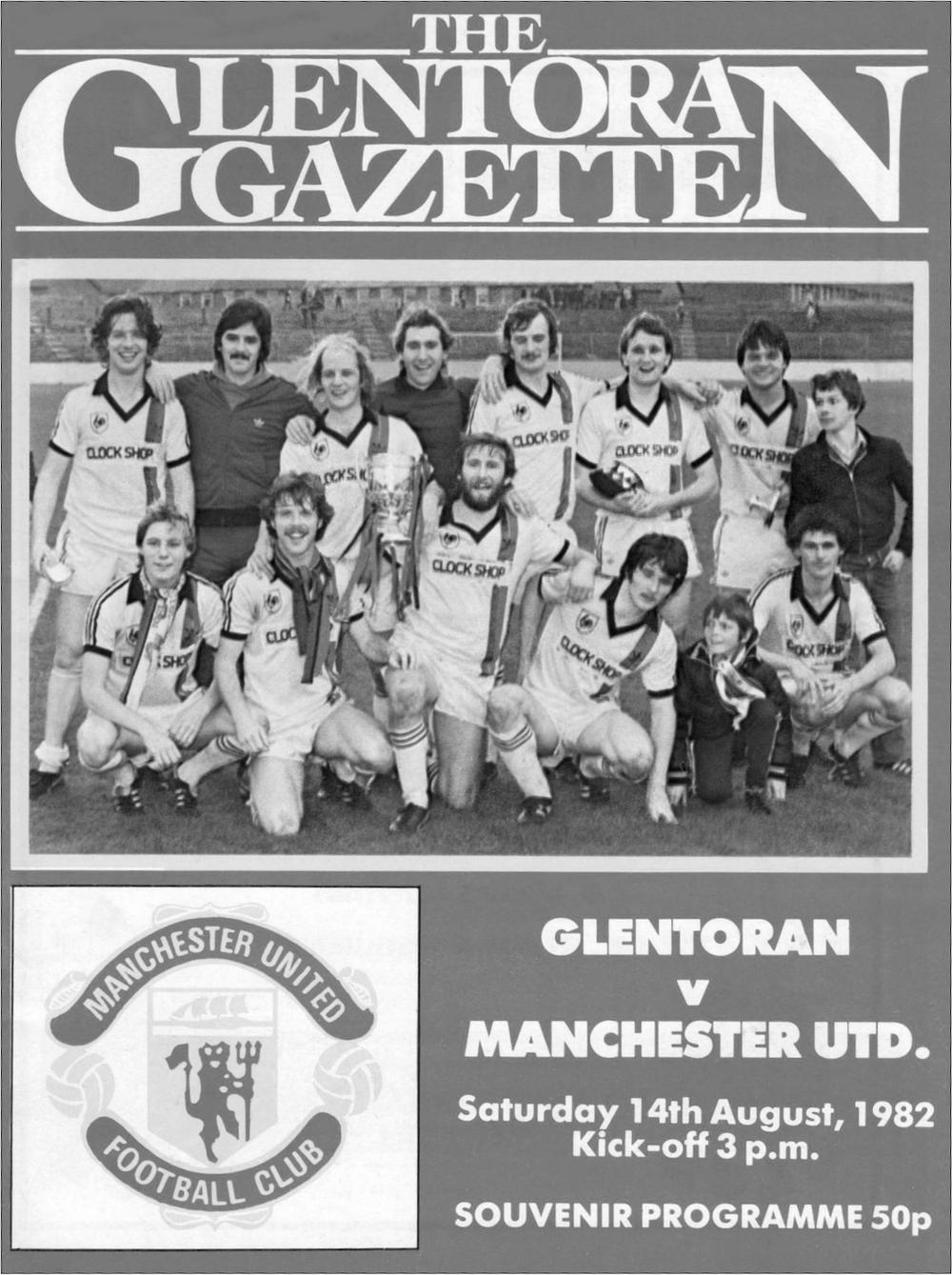
Glentoran must have gone into the return tie at Benfica’s famous Estádio da Luz with some certain Irish confidence. Many thought that the part-timers would crumble under the pressure of the occasion but again they held out for a famous draw. It was only the away-goals rule that allowed Benfica to go through to the next round.
So what about George Best? Yes, he was born in Belfast but what links him with Glentoran?
Let’s go back to the young lad from the streets of Belfast. Quite simply, George Best watched Glentoran with his grandfather as a youth and cheered his then heroes on to many a victory, and presumably on a Boxing Day duel between the Belfast Big Two.
Like every boy, George must have dreamed of playing for his team, wearing his team colours with pride, but unfortunately he was rejected by the club for being ‘too small and light’. How the club management must have kicked themselves just a few years later.
However, George did eventually make one appearance for Glentoran, in the club’s centenary match against, you’ve guessed it, Manchester United on 14 August 1982. But, the matchday programme doesn’t give evidence of that fact – so it’s just as well that a supporter who was there recalls that George not only played in the centenary celebrations, he also captained his boyhood favourites against his old club Manchester United.
From the whole match, the greatest memory of the game for one particular supporter was when George gave Ray Wilkins the run-around on the pitch, and was in fact fouled quite painfully by the then hirsute Wilkins. The absolute class of George was still with him: as he picked himself up from the foul, he also picked up the ball and handed it to Ray with an aside, ‘There, have it…’ (the ball that is).
The young boy George, who kept his granddad company on many an occasion at the Oval ground in Belfast, watching his favourite players conjure up magic with the ball, had to wait until almost the end of his career to fulfil his boyhood dream. Perhaps he never let that dream go; maybe he often wondered why his team had rejected him. Possibly one thing all of us can learn from George’s experience is to always hold on to your dreams and vision and to never let anyone take them away from you. George’s life journey took him to the great and the mighty, to fame and fortune, through the ups and the downs of his life, but he returned to his boyhood roots, to where he had at one time been discarded because of his size, to fulfil his dream.
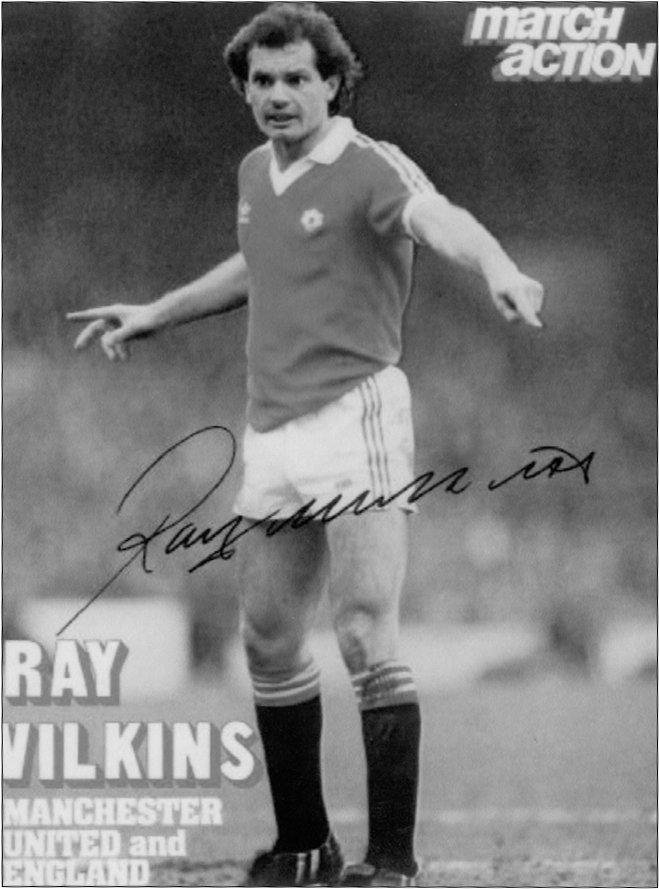
Ray Wilkins
George’s great dream was accomplished – to the delight of so many of his fellow countrymen and women watching on the terraces of Glentoran Football Club – but perhaps mostly to the delight of himself.
DOWN BUT NOT OUT!
Just in case you ever encounter the question ‘What do Henry Ford, Oscar Wilde and George Best have in common?’ at your local pub-quiz night, the answer is that all, at some time in their lives, filed for bankruptcy. Instead of Henry Ford or Oscar Wilde names such as Donald Trump, Bjorn Borg and Abraham Lincoln could also be included in the same question. But, for some unknown reason, whenever anything is written about George Best’s life (and particularly since his death), his filing, and appearance in court for bankruptcy is always mentioned.

A cheque signed by the man himself.
During the early part of his career, George had everything: good looks, long hair, unlimited money, a white Jag and legions of adoring fans. He exploded onto the football scene with outstanding natural talent, wearing his football shirt outside of his shorts and at times with his socks pushed down to his ankles. George Best was different in many ways. He was the first footballer equivalent to the emerging pop stars of the 1960s, with fan- club branches in Moscow and Tokyo. Whatever he did made the gossip pages. This exposure followed him through the dizzy heights of winning cups, trophies and accolades and perhaps even more so through the decline of his career and his departure from Manchester United.

Malcolm Brodie, then the sports editor of the Belfast Telegraph, who covered all of Best’s games for Northern Ireland, said, ‘George had a phenomenal career, he was a fantastic footballer. He was one of the best in the world, up there with Pelé, Maradona, Cruyff and Eusébio. George had everything and some of his performances were outstanding. In 1967, at Windsor Park, he took Scotland apart in a 1–0 victory. I do not think there has been a finer display of football than that day. You could not write a book about his personal life, as it was incident-packed. He often hit that self-destruct button, but he was a wonderful person and was his own harshest critic.’
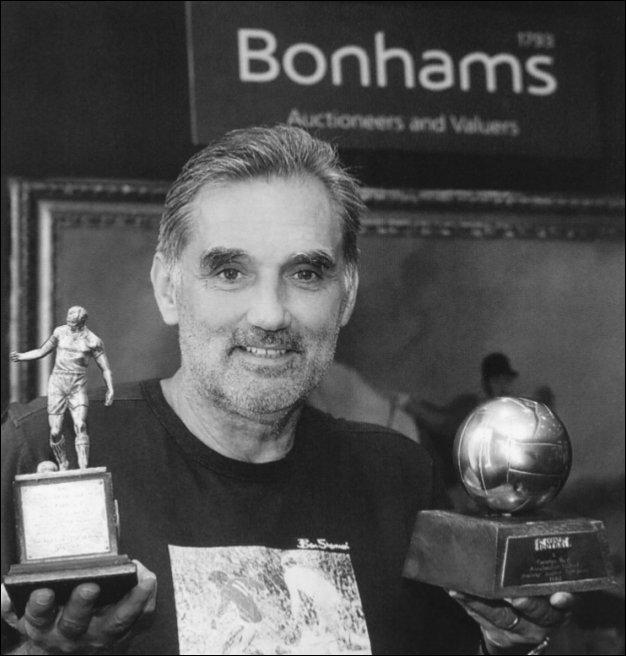
George auctioning memorabilia.
Frequent and unexplained upheavals with club management were seen at the time as the actions of a fractious athlete. Later, it came to light that Best had a drinking problem. In 1982, while playing in San Jose, California, Best was suspended indefinitely by the club and entered an alcohol rehabilitation programme.
When George returned to Britain in 1982 after his season with the San Jose Earthquakes, he was met with a tax bill for £16,000. He offered to pay £10,000 immediately and the rest in six months, but was told that this was not acceptable. During a bankruptcy hearing in London in 1983, Best told the court, ‘I am an alcoholic. My drinking over the last 12 years has been the root of my trouble.’
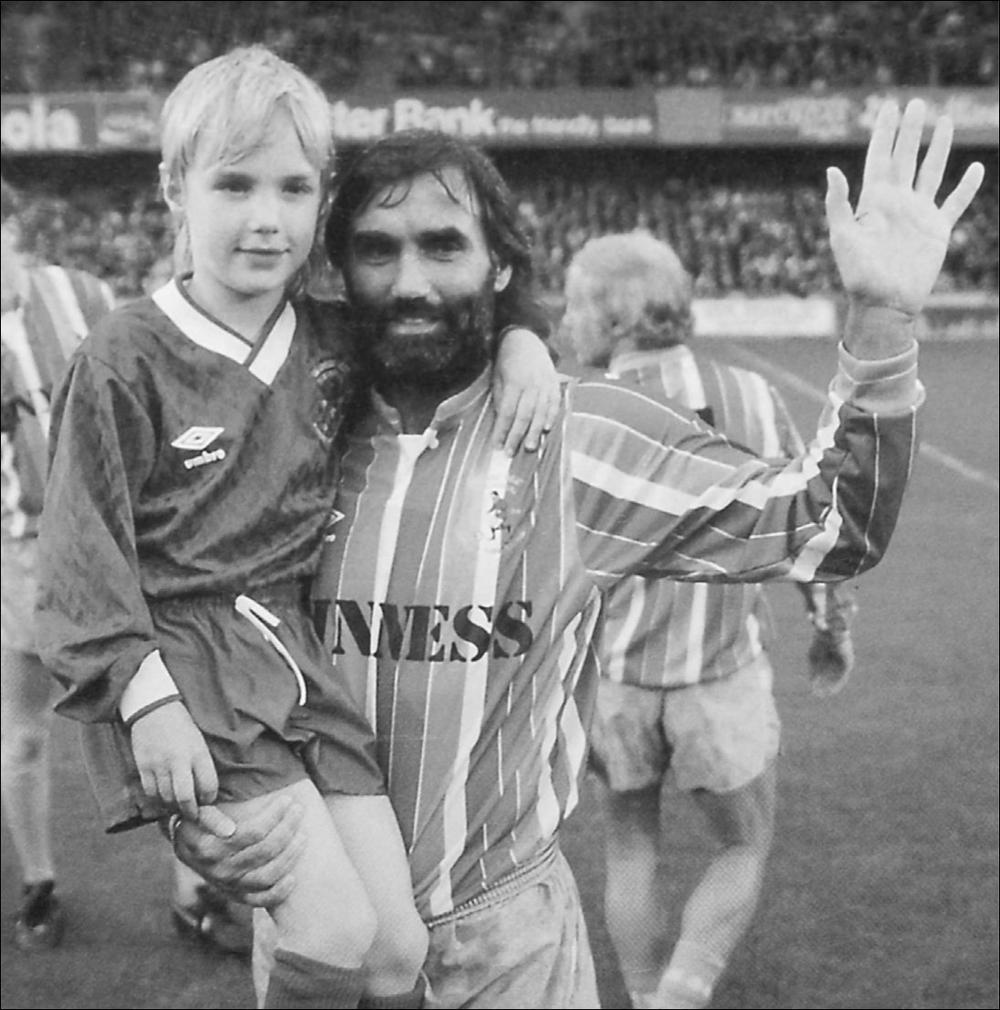
George and Calum
Just hours after his court appearance for failing to pay back taxes, George was hit over the head with a beer glass in a London pub. On top of all that, for George, the result of the unacceptable £10,000 down payment was a ten-year wrangle that, with the compound interest, cost him more than £60,000 to settle. Just before Christmas the following year, he was jailed for three months for drink driving, assaulting a policeman and jumping bail.
Four years later, with the help of £75,708 raised by a testimonial match, George began to emerge from the shadow of bankruptcy. Malcolm Brodie said, ‘I watched him throughout his career and dealt with him. I helped organise his testimonial, which raised the finance and got him out of bankruptcy. But he was a generous person, not a mercenary, and did a lot for charity.’
George Best was one of many that faced bankruptcy, the famous and the not so famous, but not all have their personal financial embarrassment as headline news. At the time of his bankruptcy George also had to deal with his increasing addiction to alcohol. Every person going through bankruptcy feels alone or that they are the only ones suffering from the stress and strain of financial struggles, and George would have been no different. He would have felt alone in a crowded world where some people feed off the downfall of others, even though it would have been just as easy to give some kind of support and encouragement.
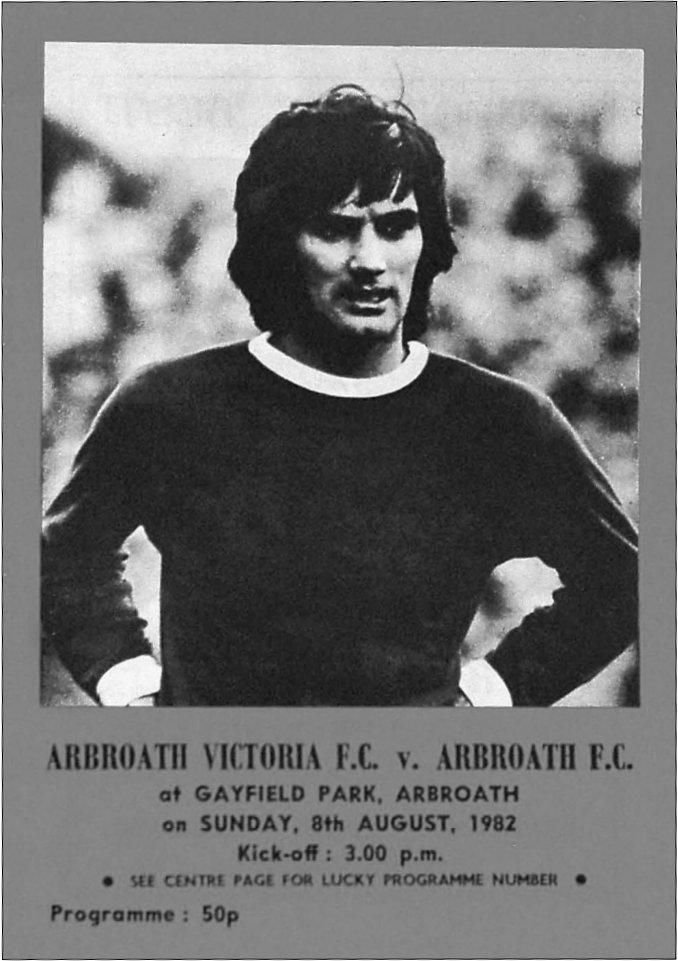
Thank goodness George still had those real people around him who wanted to be there for him. Ultimately, his popularity and skills on the football pitch freed him from bankruptcy. For his testimonial a 25,000-strong crowd, the largest in Belfast for 20 years, braved persistent rain to pay homage to the man George Best.
THE BEST IN SWINDON
Sounds a bit dramatic, doesn’t it? George Best: The Swindon Connection. As if the lovely Wiltshire town had some sort of clandestine effect on the career of arguably the world’s greatest footballer. As if Swindon made a difference in the life and times of a soccer legend – it’s not that! It’s that Swindon saw the very best – and at times the worst – of George Best during his life. For 40 years, he both thrilled Swindonians on the pitch and, once or twice, frustrated them off it. But that was George.
Heather Hewlett Fundraiser 1982
George Best’s last playing appearance in Swindon earned him the then princely sum of £300. That was the amount the Evening Advertiser stumped up to secure the services of the former European Footballer of the Year at a special game in aid of Heather Hewlett, the widow of speedway rider Martin Hewlett, who had died earlier that year.
It was an all-star game that not only included some of football’s best-known names (Channon, Rogers and Summerbee) but also other sporting celebrities such as cricket’s Viv Richards and Swindon’s own champion jockey John Francome.
Best’s show helped boost the attendance to over 7,000, and contributed in swelling the charity’s coffers by over £5,000. The 36-year-old Best even ended up on the winning side, triumphing 12–9! He scored five goals.
On stage
George Best & Rodney Marsh
Questions and Answers at
The Wyvern 1992
When George Best arrived in Swindon in November 1992, his playing career was well and truly at an end. He hadn’t played since turning out for lowly Bournemouth AFC in 1983, and it was the theatre and after-dinner circuit that was paying the bills (or tax demands, depending on whether the Inland Revenue were in touch or not).
He had formed a formidable partnership with former team-mate Rodney Marsh and they had sold out venues across the country with their question and answer show ‘An Evening with Best and Marsh’. It was two hours of brilliant entertainment. Best at his charming best; and Marsh contributing with equal verve in what one person who attended described as ‘a dream night for any football fan’.
Both amusingly recounted their halcyon days at Fulham in the 1970s, and at Manchester United and City during the Swinging Sixties. Never ones to finish a good night at 10.30 pm, Best and Marsh then continued their comedic partnership in the bar at the Thistle Hotel afterwards as well, signing autographs and enjoying a drink with fans like Swindon was their home town. By all accounts they finally called it a night at 4 am. Vintage Best!
Premiership Forum 1994
As part of Sky Sports coverage of the Premiership in 1993/94, the television channel held an ‘Experts Forum’ at the venue of their Monday night ‘Live’ game, and on 4 April 1994, the one and only George Best was a guest panellist at the County Ground alongside Swindon Town F.C.’s Don Rogers.
Both reported on another disappointing defeat for Swindon, who lost 1–0 to Sheffield Wednesday in front of 13,927 fans. Diplomatically, Best did try to put a positive shine on the Robins’ performance, but even he couldn’t hide the fact that Town were staring relegation in the face – and leaking too many goals.
It was such a dismal game that it could have driven anyone to drink. Not George! He surprisingly looked sober all night.
FA Cup Thrashing 1977
Fulham Fall-Guys: Bobby Moore, George Best
and Rodney Marsh
This was almost Swindon Town versus the Harlem Globetrotters. An FA Cup mismatch if ever there was one. Swindon had John Trollope, Ray McHale and errr… no one else we can remember. Fulham had George Best, Rodney Marsh and England’s World Cup-winning captain Bobby Moore. Except these footballing legends hadn’t managed to see off the Swindon Town boys in the first match. It had ended 3–3 at Craven Cottage on a chilly 8 January 1977. Moore and Best were so confident of victory they’d been out ’til 5 am the night before.
Three days later, though, Fulham’s long-toothed galacticos got the thrashing of their lives – 5–0 in the replay! Swindon Town ran riot! Best, Marsh and Moore didn’t run at all.
Whether they had been on another of their famous King’s Road pre-match warm-ups, no one knows, but, while Swindon Town fans celebrated, the three amigos trudged off never to feature in the FA Cup again.
In a sad bit of symmetry, Best had started his career with an historic youth team win over Town in 1964; and he ended it here with a performance that was so off-key some Town fans can’t even remember him playing.
De Vere No Show 1996
Gone AWOL: George Best
Over 200 guests had paid £50 to hear him tell humorous tales of scoring both on and off the pitch. All had dressed up in their best bib and tucker. George Best, footballing icon, was the star guest at a special Sportsman’s Dinner at the De Vere Hotel, Swindon, in spring 1996. Even his manager had calmed the organisor’s nerves by confirming that she had bid farewell to her sober client at Paddington Station at 6 pm.
Except he never arrived! What he found on the 125-Intercity train to Swindon that distracted him no one will ever know. The usual suspects Johnny Walker and Jack Daniels were the hot favourites, though. Strong rumours of a beauty pageant taking place in Swansea were also blamed.
At 10.30 pm, with George un-contactable, the miserable decision was finally made to announce that the main attraction wasn’t coming. ‘Unforeseen circumstances’ was given as the official reason for Best’s no-show.
The evening was partially saved by free drinks at the bar and a quick routine by a comedian. He even quipped that George had been delayed launching a ship – but that the vessel had gone seven miles out to sea by the time they got the bottle of champagne out of Bestie’s hand!
Mike Summerbee – the 1960s
Best Buddy: Mike Summerbee
George Best’s glorious heyday was surely the 1960s. Christened ‘El Beatle’ by the Press, he lived a superstar lifestyle where he somehow managed to fit booze, birds and boutiques in between scoring magical goals for Manchester United. He well and truly lived the playboy dream, and his best friend during these heady times was none other than former Swindon Town legend Mike Summerbee.
After playing over 200 games for the Robins and becoming a firm fans’ favourite at the County Ground for six years from 1959, Summerbee swapped the quiet life of Swindon for the bright lights of Manchester City in 1965.
And then he met George Best!
Immediately they became the best of friends, and almost inseparable in their quest to sample everything Manchester’s nightlife had to offer.
In 1966, they opened a boutique together called Edwardia as they enjoyed the bachelor lifestyle to the full. ‘We were both single and basically had the time of our lives,’ Summerbee said. George even helped Mike meet his wife, when he introduced the pair at a nightclub in Manchester. The partying only ending in 1969, when Summerbee married. George was, of course, the best man.
And so there you are! What does a ’60s icon, who was a footballing genius and national superstar, have to do with the pretty town in Wiltshire? Quite easy really, Swindon’s loose connection with the talent of a genius was none other than George Best.
Many thanks to Phil Poulton for the use of some information from Swindonweb.
AFC Bournemouth
March 1983 – May 1983
24/3/83 Signs contract
26/4/83 Home debut v Newport
Crowd of 9,121
16/4/83 Final away game v Southend
Crowd of 4,275
11/10/80 Final home game v Wigan
Crowd of 4,523
He was 15 days short of his 37th birthday
| Appearances | Goals |
| 5 | 0 |
THE CHERRY ON AFC BOURNEMOUTH’S CAKE
‘Love him or hate him George Best certainly fires the imagination of fans and reporters alike’ was the club comment in the programme for the last ever match he played for AFC Bournemouth. George essentially finished his legendary soccer career in San Jose, scoring 21 goals in 56 games from 1980/81. After returning for one last season with AFC Bournemouth in the Second Division, Best retired for good in 1983 at the age of 37.
It is interesting to note that Northern Ireland finally made it back to the World Cup in 1982 while 37-year-old Best was with AFC Bournemouth. Ironically, one of the stars for them in Spain that summer was a 17-year-old prodigy called Norman Whiteside, a Manchester United youth player discovered by Bob Bishop, who a generation earlier had sent a telegram from Belfast to Matt Busby with the legend ‘I think I’ve found a genius’ upon his sighting of one George Best.

But how did George end up with the Cherries?
The very last programme to have the legendary George Best as part of a football team was when AFC Bournemouth played against Wigan Athletic, 7 May 1983. In it was an explanation of how and why George graced the south coast with his genius: ‘Now a more portly 36, George Best is anxious to once more regain acclaim of soccer’s public after years in the wilderness wasted on gambling, drinking and fast cars. And Bournemouth’s fresh-faced new manager Don Megson, who laments a dearth of star quality in the game today, was pleased to give him the opportunity.’
‘We sat down and talked about the situation at Dean Court and I felt that bringing George in the team would not be weakened and it would provide a real star name for the fans,’ explained Megson.
George also played an important role off the field as well, helping the new management team take the Cherries to their public. George said, ‘The one thing I learned from playing in the United States was how important it is to get involved in the community… We are trying to do this here and the kids love it when we go out and coach them.’
For George it was good to hear the cheers once more and he said, ‘The crowd have been tremendous towards me. We are in a position now where we are safe so we can concentrate on planning for next season which is the important thing.’
But it wasn’t to be ‘next season’ for George Best. Not only was AFC Bournemouth v Wigan Athletic the last game he played for Bournemouth, it was also the last professional game he was ever to play. How would the referee for the day (although on the programme he was down as linesman), W. T. Phillips have known that he was reffing such a momentous, but somehow very sad match – of course he couldn’t have known, but what he did do was to get the programme signed by George. Certainly something to keep to show the grandchildren!

The then manager of AFC Bournemouth commented, ‘From my own point of view, and even more important the players, the short time George has spent with us he has been a great guy, trains hard, loves the game and joins in everything with enthusiasm without any superstar fuss. Whatever the future holds for George and he is not with us next year, I feel sure all at the club will join me in wishing him well.’
But life goes on. And on 20 May 2005 a website article was posted regarding another great find at AFC Bournemouth with a question in the title – ‘The next best thing?’ it makes interesting reading:
…Curtis Allen, apparently. A 17-year-old Bournemouth youth player: ‘a young David Beckham’ and ‘the Irish Rooney’. He has scored 37 goals in 33 games this season.
‘George Best, another phenomenal player from Northern Ireland, watched Curtis Allen play in a soccer match seven years ago. “This boy is one to watch out for. He’s fantastic”, Best said of the then 10-year-old Allen. The December 2004 edition of the “UEFA Champions League” magazine reported that Allen was one of five young players to watch out for in Europe.’
George commented, ‘There are very few entertainers around now which is a shame for the game. It is still our national sport and the only way to bring back the crowds is to entertain them and that can only happen through individuals.’

George Best certainly lived up to that comment! Whatever situation he found himself in he definitely entertained, at times he was not under-stood and even more times he was used as cannon fodder for the press. No matter what, Saturday, 7 May 1983 was definitely a poignant day – it was the end of an era that spanned over 20 years and encap-sulated a life in football that started with the genius, the lad off the streets of Belfast and ended in George Best still with that special something, and still ‘being a nice guy’ with the Cherries in Bournemouth.
Brisbane Lions
(Struggling Team)
3 July 1983 – 17 July 1983
3/7/83 Debut v Sydney Olympic
Won 2–1
8/7/83 v St George (H)
Lost 3–0
10/7/83 v Marconi (A)
Drew 1-1
17/7/83 Last game 0–4 home defeat
1,600 crowd
| Appearances | Goals |
| 4 | 0 |
Osborne Park Galeb
24 July 1983
24/7/83 v Melville Alemannia, won 2–1
Crowd approx 2,000
| Appearances | Goals |
| 1 | 0 |
